Cambodia - 2007
Phnom Penh
I had a 4-week Indochina trip in May-June 2007.
(Melbourne – Bangkok – Thailand – Laos - Vietnam - Cambodia -Thailand – Bangkok - Melbourne)
After 11 days in Vietnam we headed by public bus, (the only one used by IntrepidTravel on this trip), to the Cambodian border.
It simplified the task of getting the Cambodian visa ($30) as the conductor on the bus did all the paperwork.
The Cambodian official handing the bus conductor our passports at the Moc Bai (Vietnam) - Bavet (Cambodia) border.
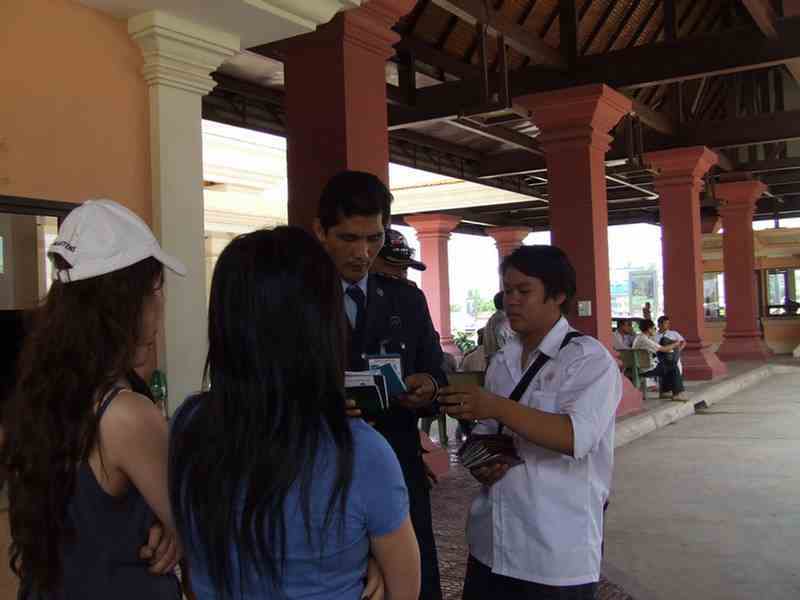
A basket of fruit of the lotus flower.
In Cambodia, the lotus flower is most often found on the periphery of flooded rice paddies or in stagnant pagoda ponds.
In other Asian countries, the plant’s flowers, leaves, stems, and rootstalks are prepared as garnishes and teas,
or used as vegetables in salads and stir fries.
The plant is also traditionally used for medicinal purposes. It contains the morphine-like alkaloids nuciferine and aporphine.
Throughout the world, the lotus’ dried seed pods are used in floral arrangements, and in Burma,
silk-like robes for monks and Buddha images are painstakingly woven from the fibres found in the lotus’ stalk.
To Cambodians, however, the lotus has one true function, its seeds are a tasty snack.
The lotus’ fruit, or seed pod (which bears an uncanny resemblance to the spout of a common garden watering can),
is commonly sold throughout the Khmer Kingdom.
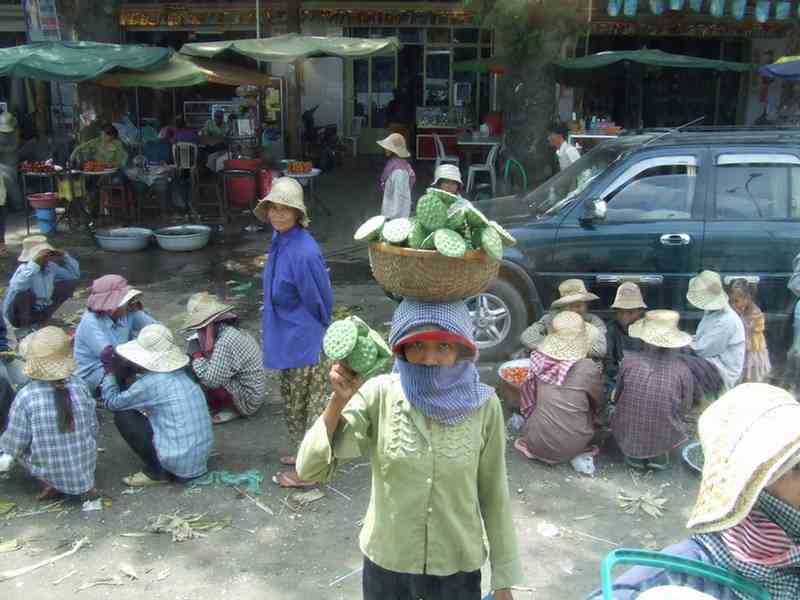
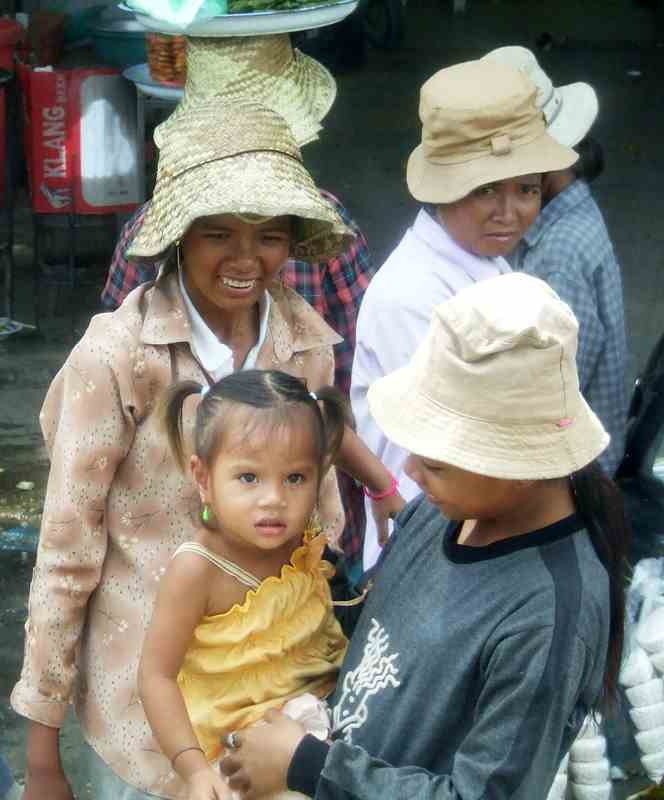
We crossed the Mekong River on a ferry at Neak Loeung
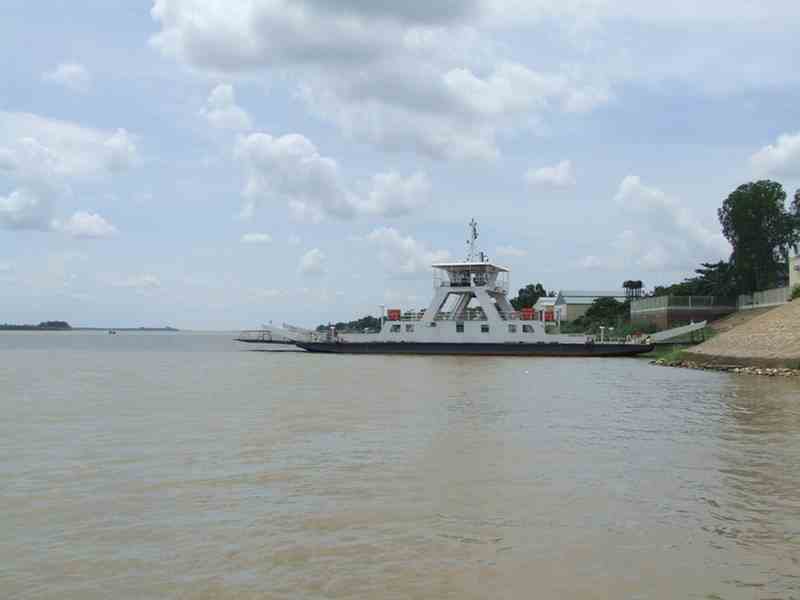
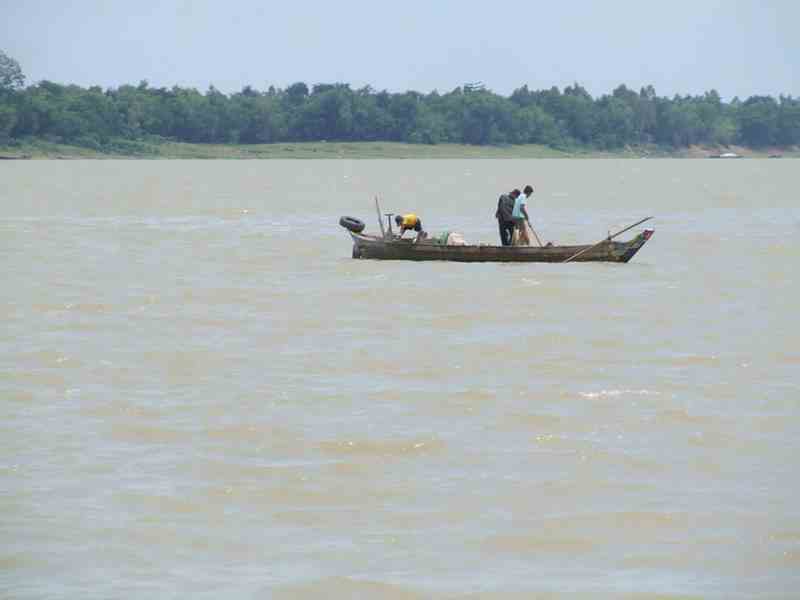
We drove along the Mekong River into Phnom Penh
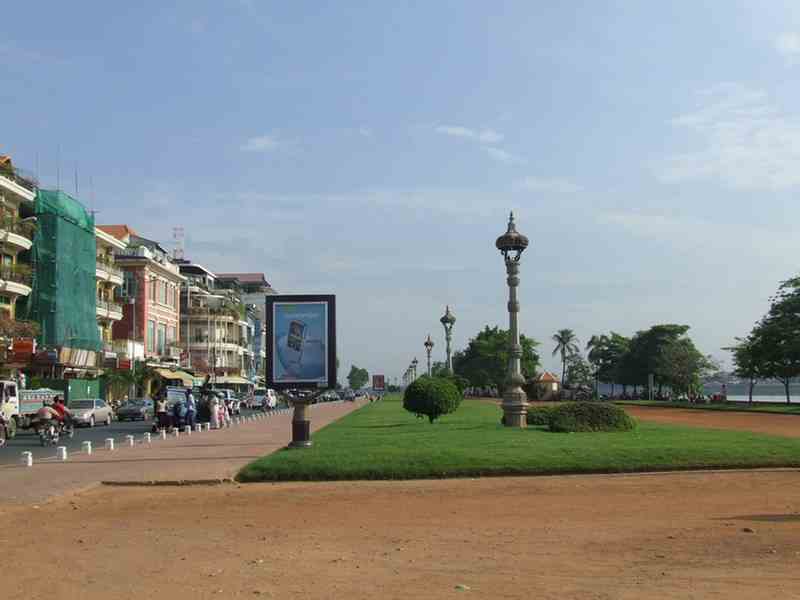
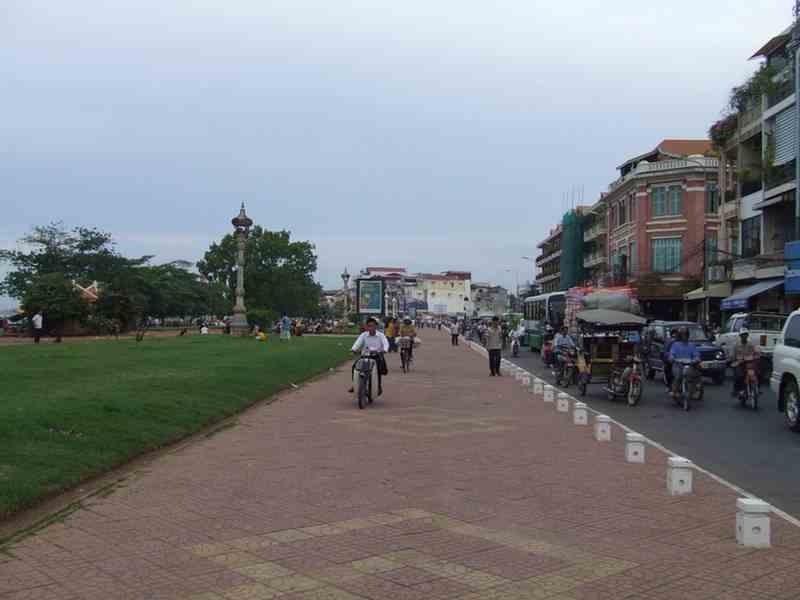
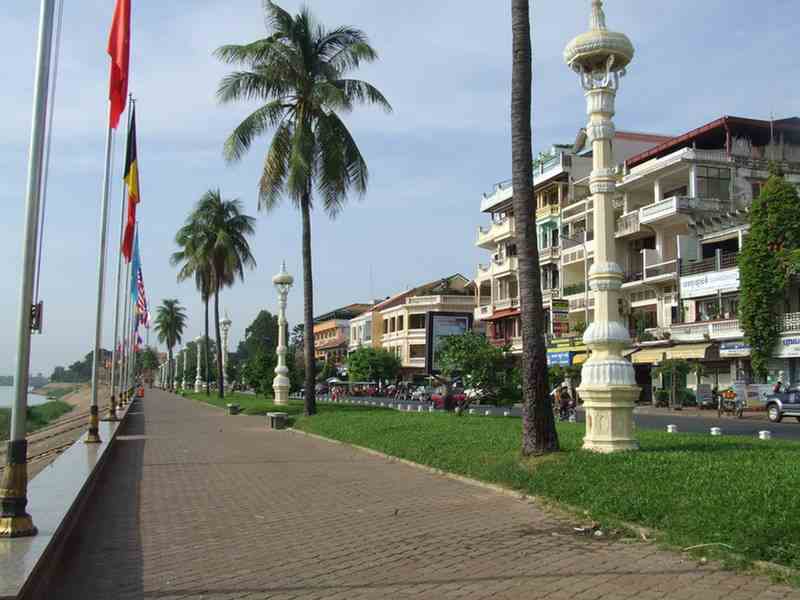
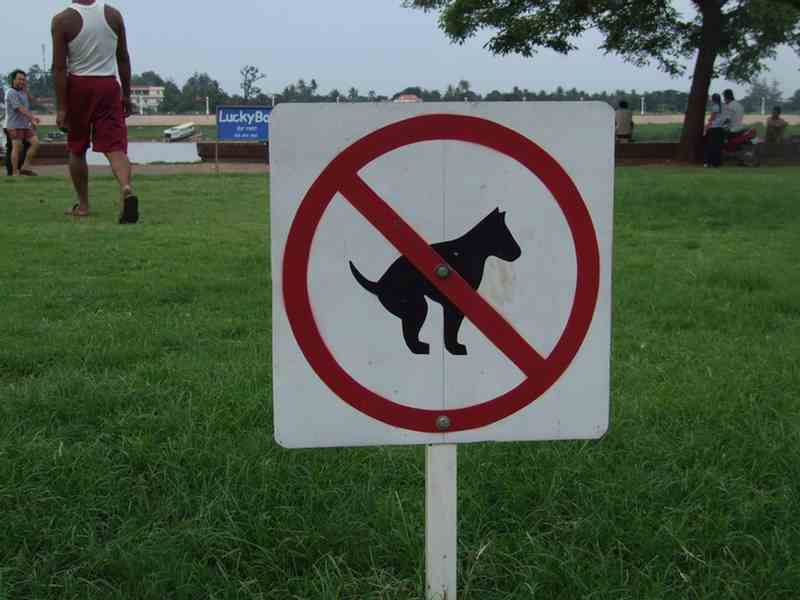
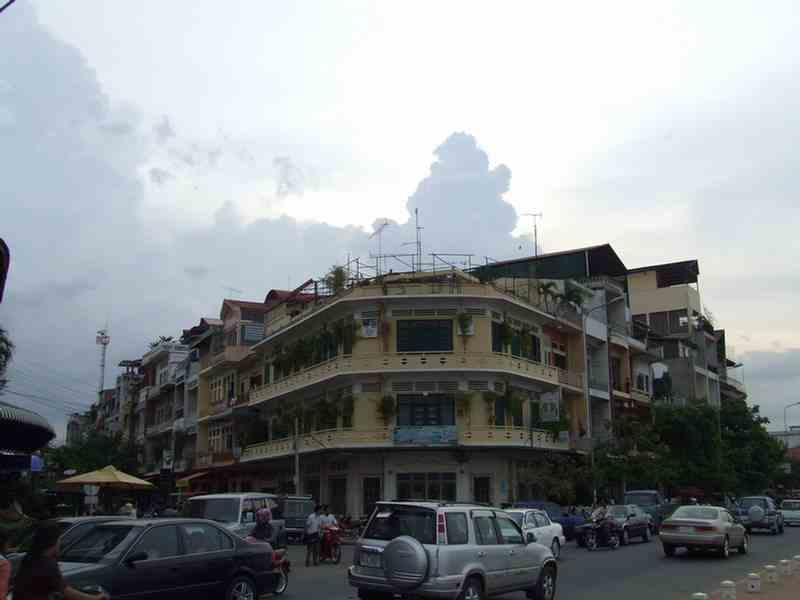
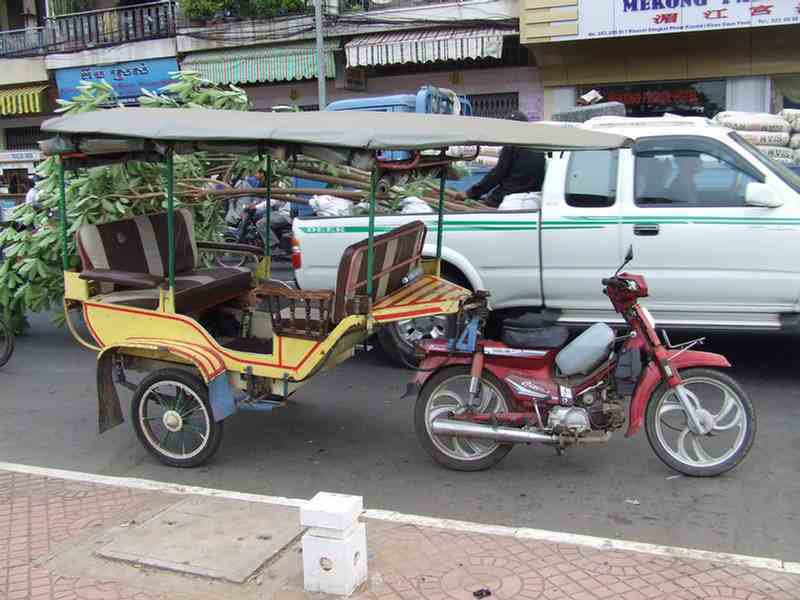
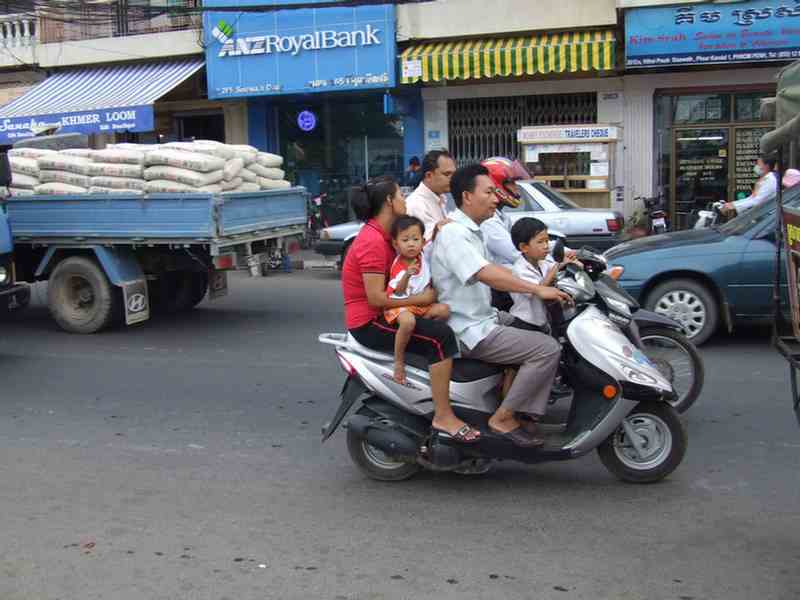
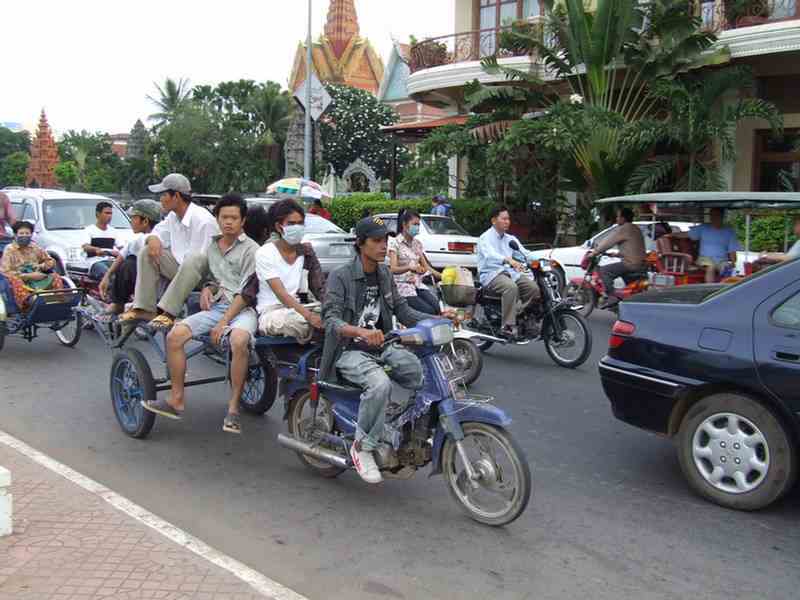
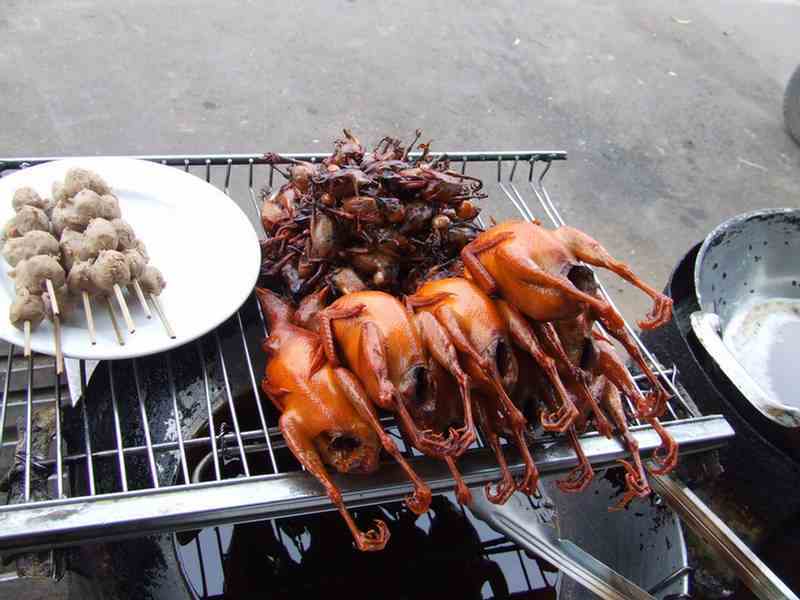
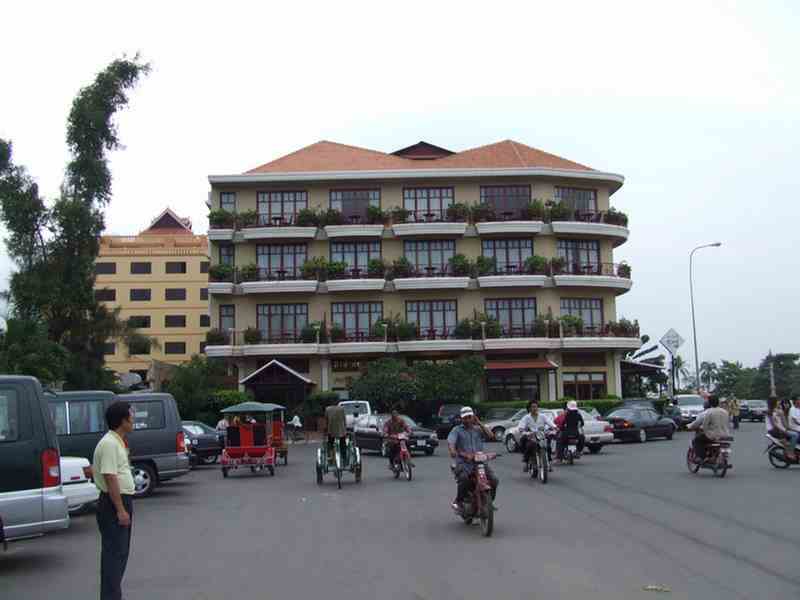
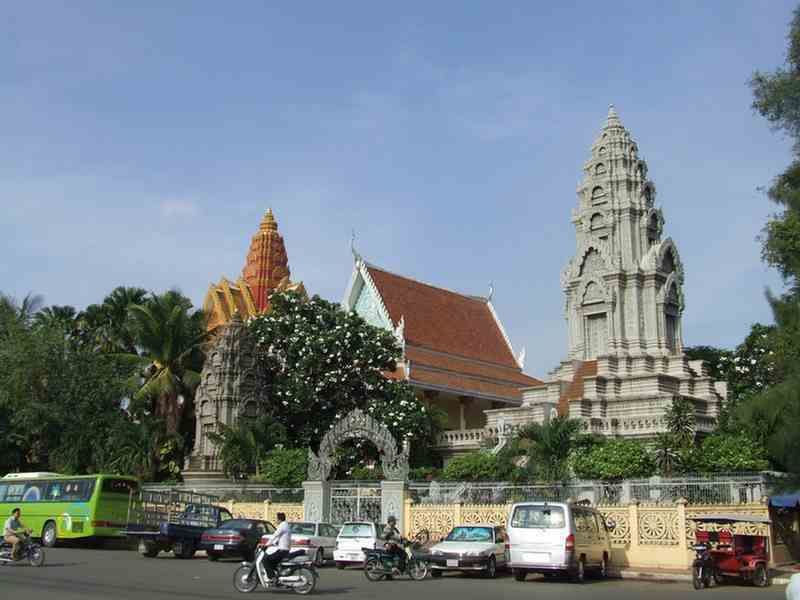
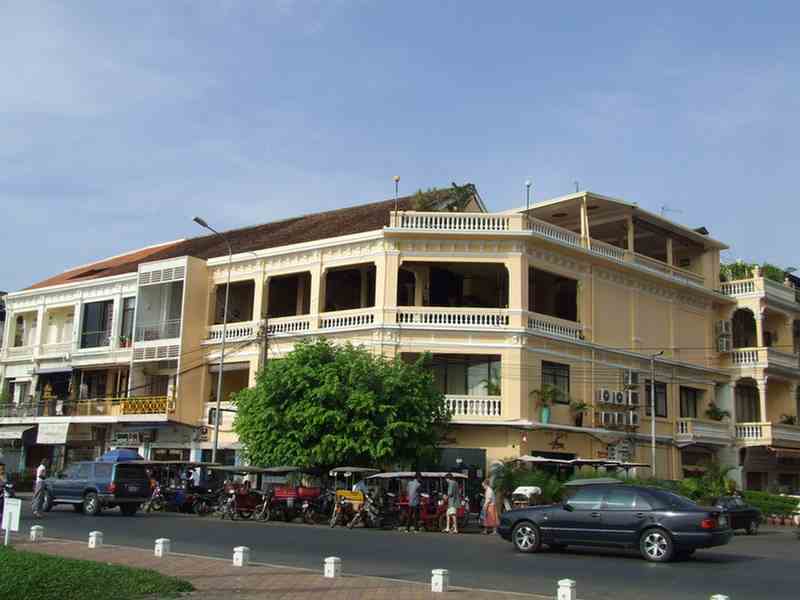
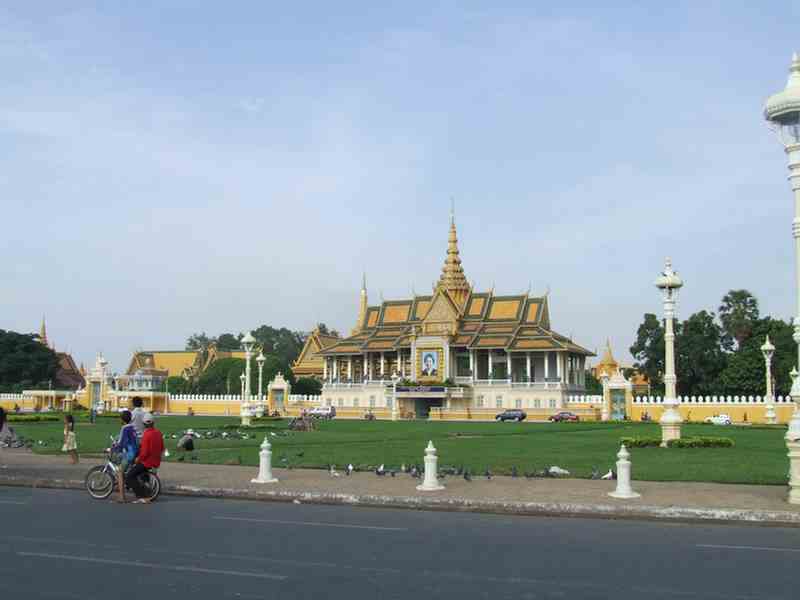
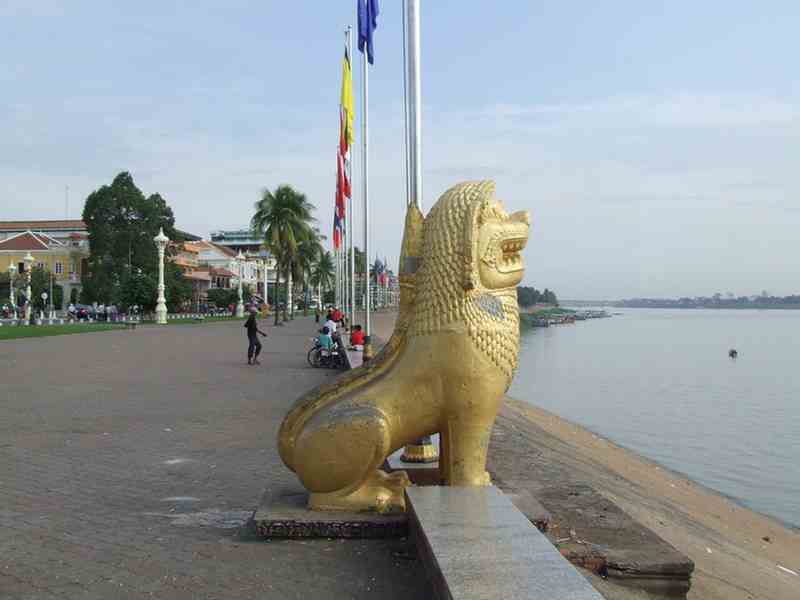
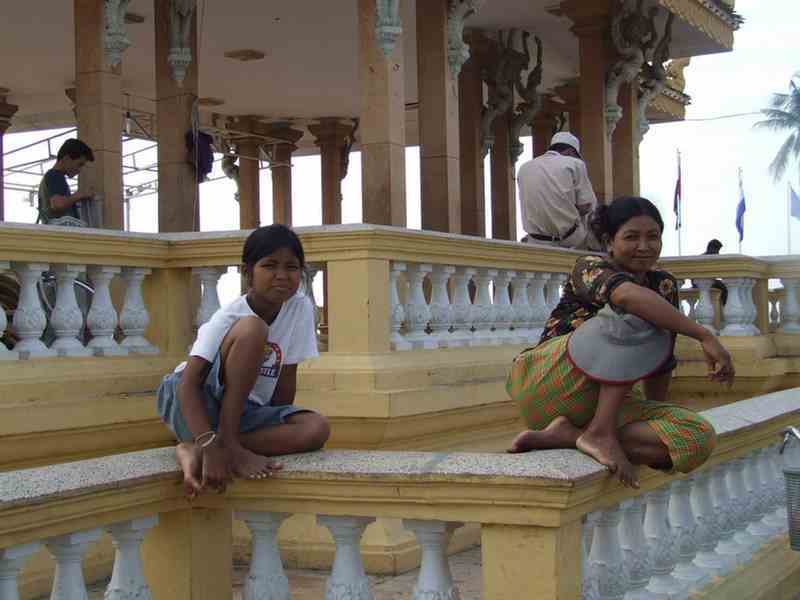

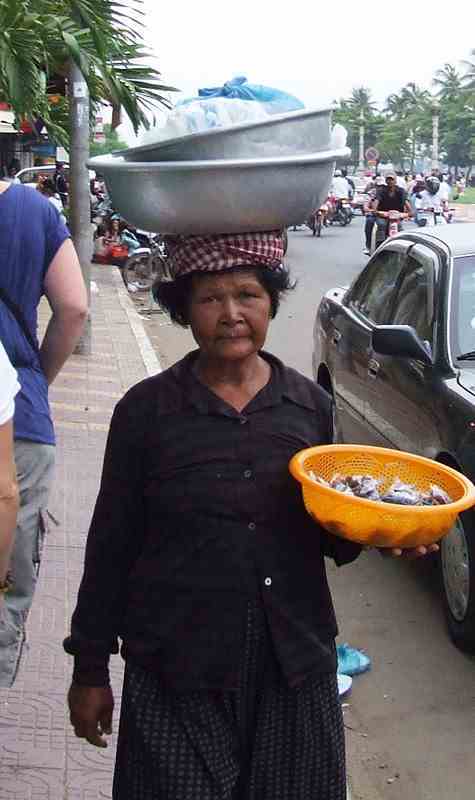
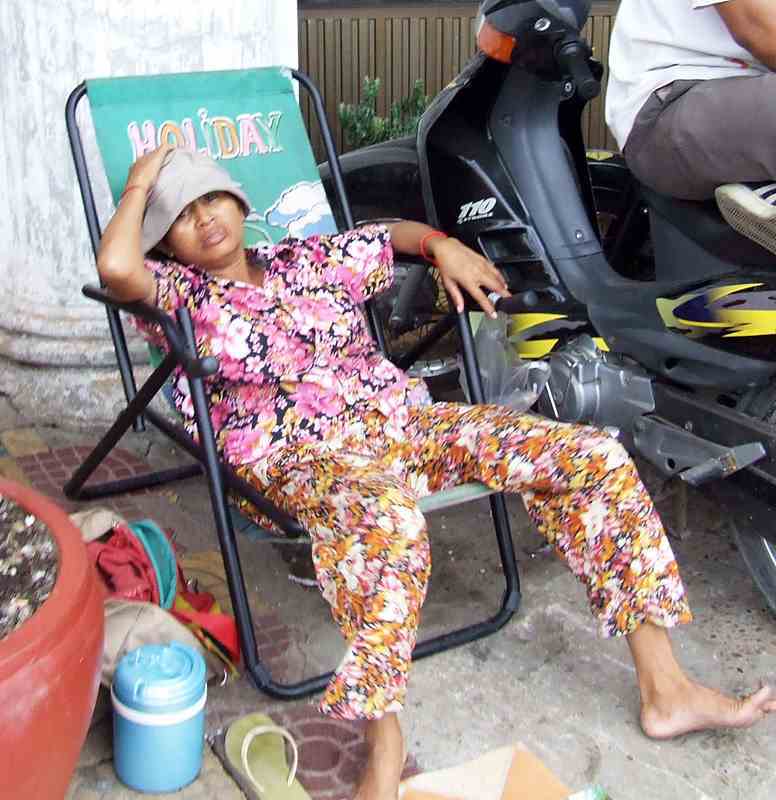
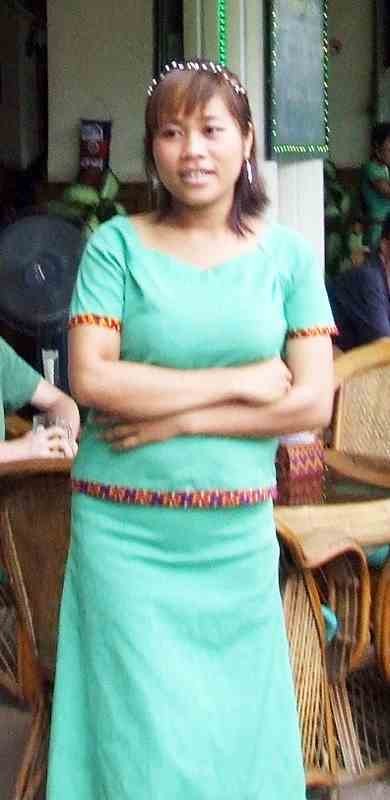
Wat Phnom
Located on a small hill, the Wat marks the legendary founding place of Phnom Penh.
Legend has it that in 1372, Lady Penh (Yea Penh) fished a floating koki tree out of the river.
Inside the tree were four Buddha statues. She built a small hill (phnom means hill)
and a small Temple (Wat) at what is now known as Phnom Penh.
The current temple was built in 1926. The large stupa contains the remains of
King Ponhea Yat (1404-1467) who moved the capital from Angkor to Phnom Penh in 1422.
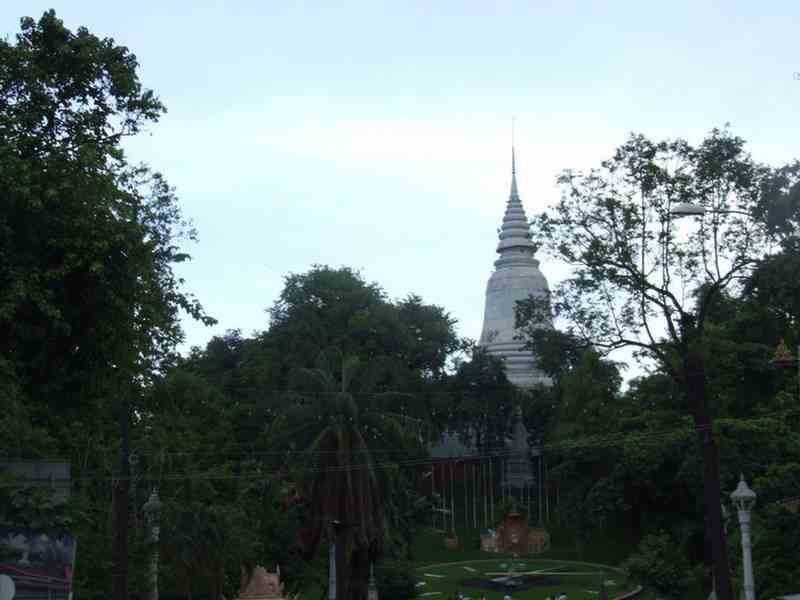
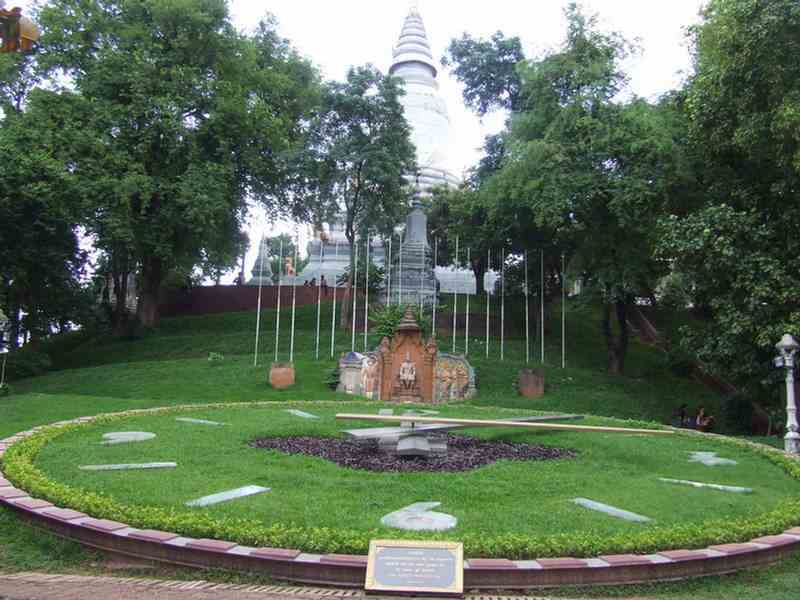
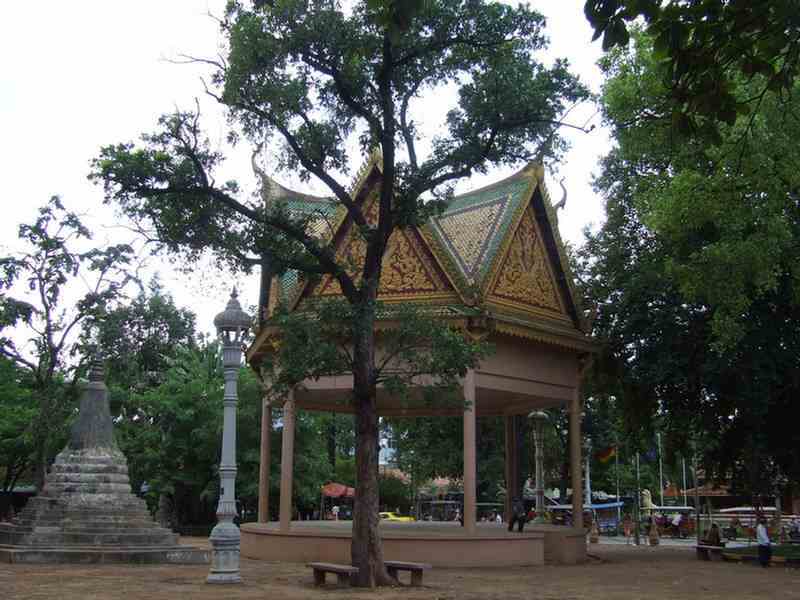
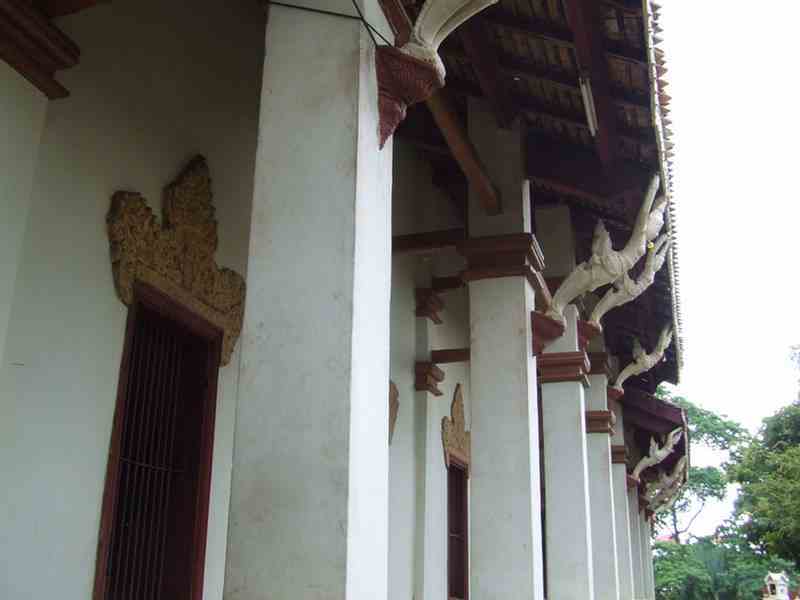
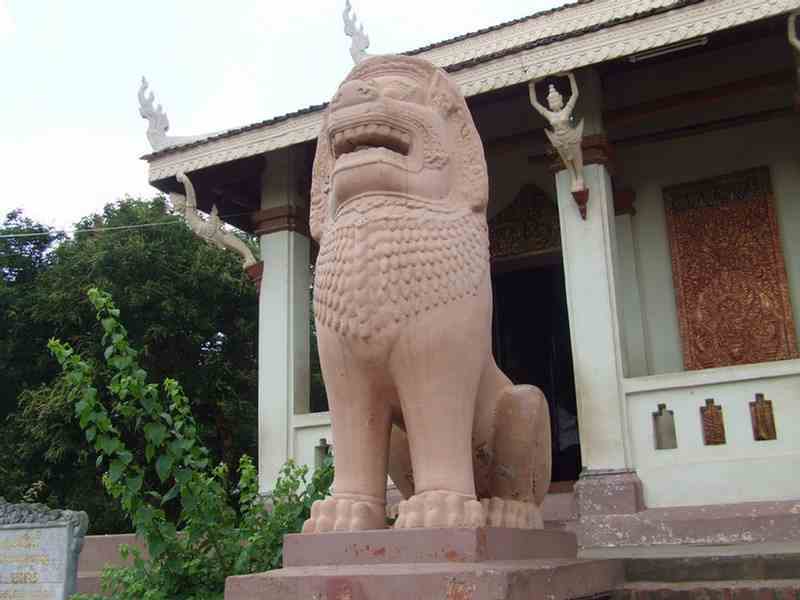
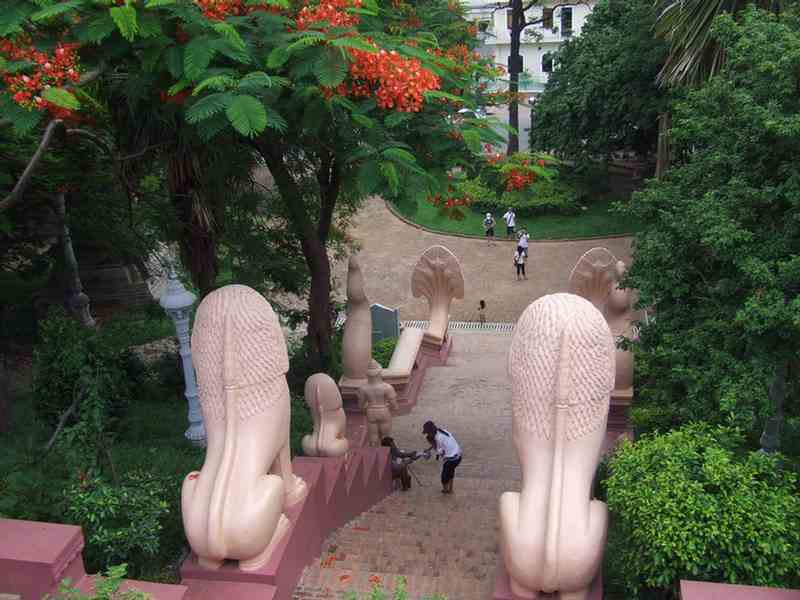
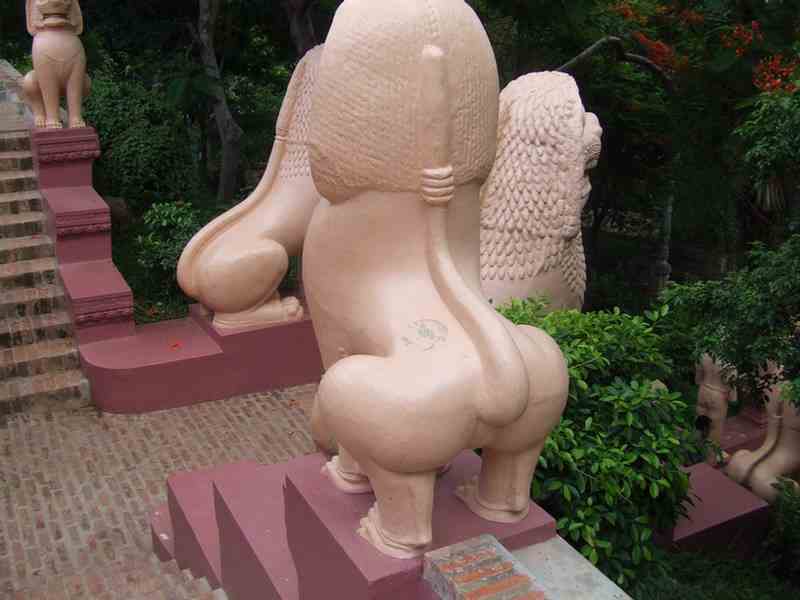

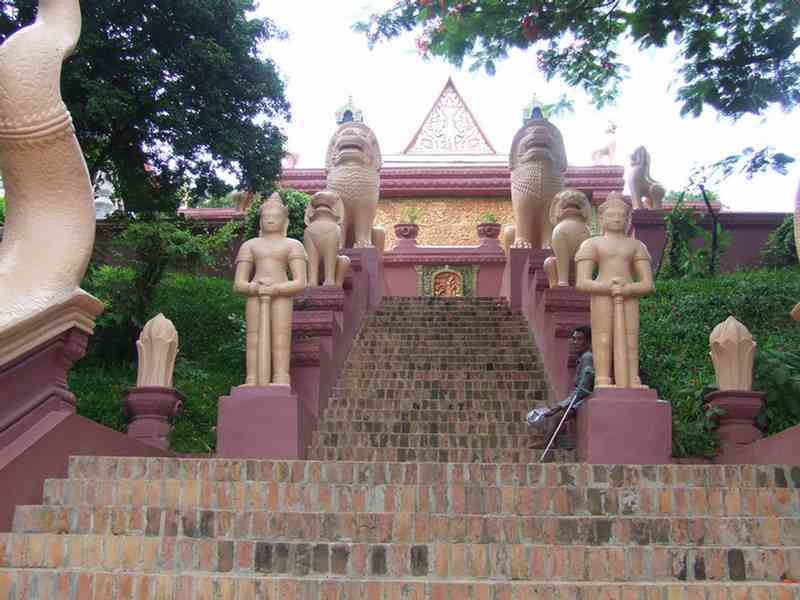
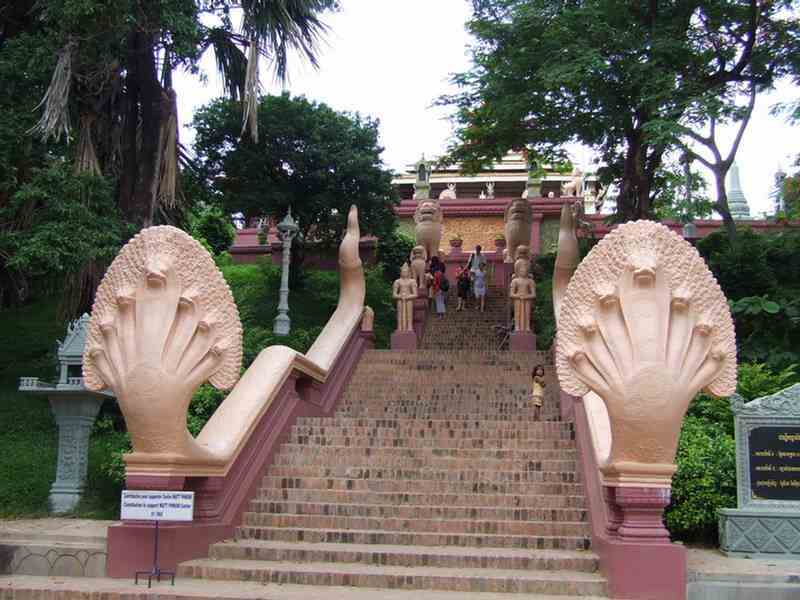
The Royal Palace
The building of the Royal Palace began in 1866 and opened in 1870 under King Norodom.
The compound houses the Royal Residence, the Throne Hall, the Silver Pagoda along with other buildings.
It is set in pleasant gardens.
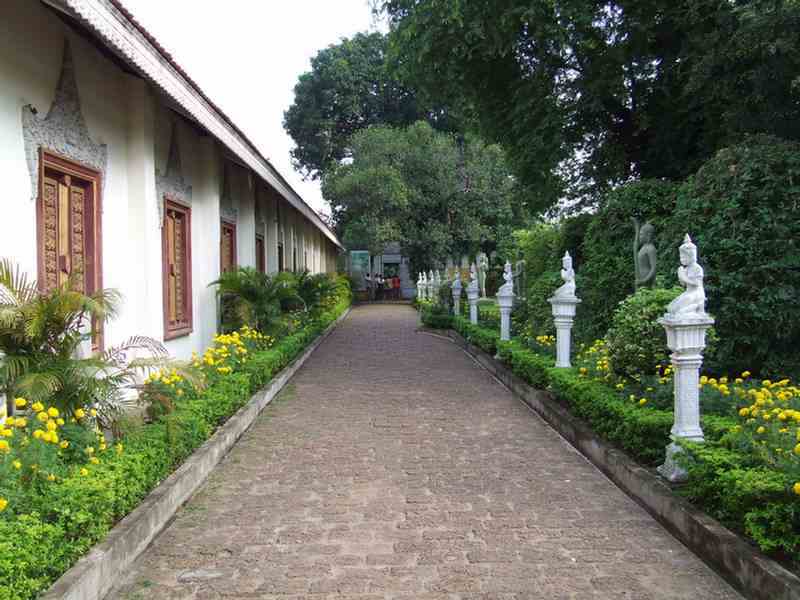
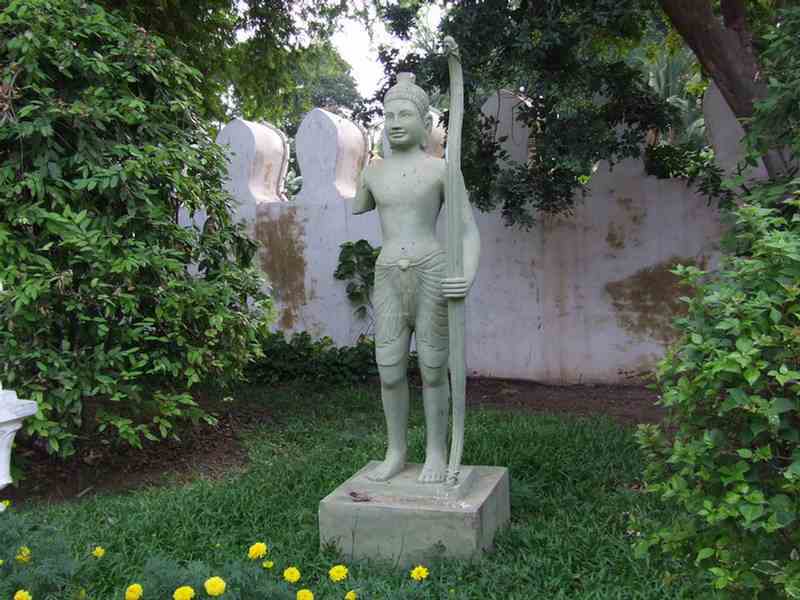
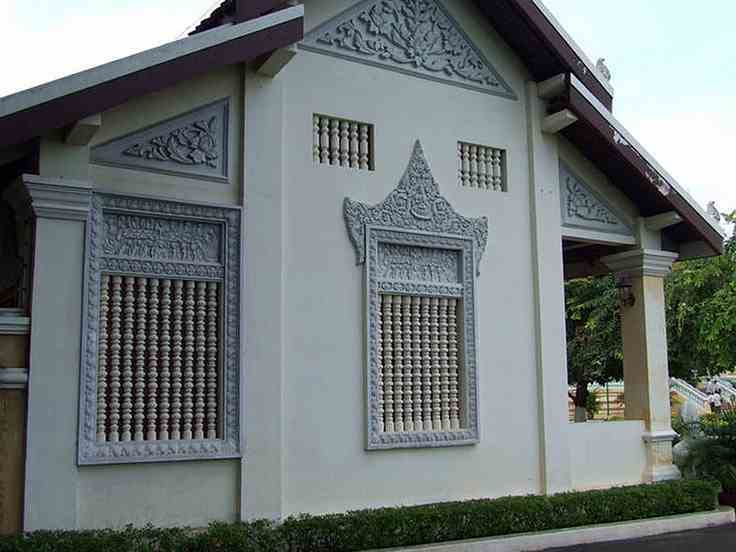
The Throne Hall
The Khmer name for the Throne Hall is Preah Thineang Dheva Vinnichay meaning the "Sacred Seat of Judgement."
The Throne Hall is where the king's confidants, generals and royal officials once carried out their duties.
It is still in use today as a place for religious and royal ceremonies (such as coronations and royal weddings)
as well as a meeting place for guests of the King.
The central, 59 meter spire is topped with the white, four-faced head of Brahma.
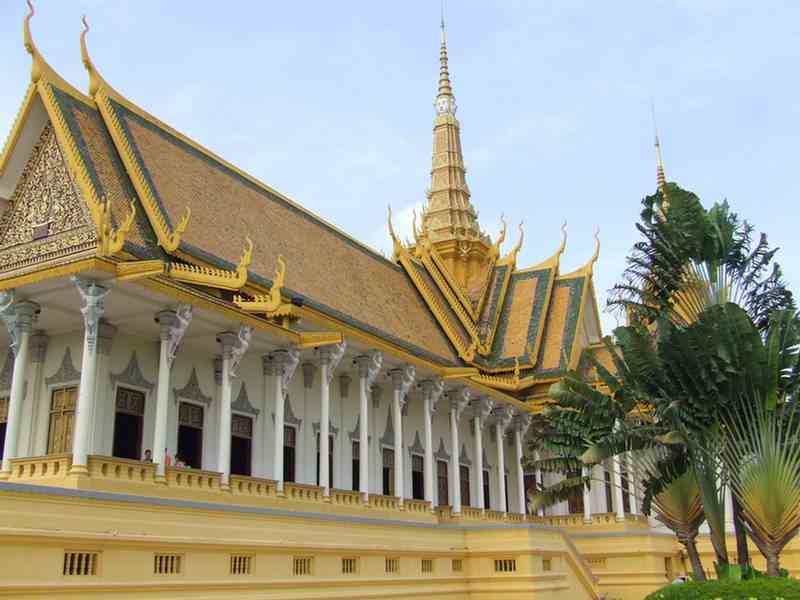
Chan Chhaya Pavilion
The Preah Thineang Chan Chhaya ("Moonlight Pavilion"), is an open-air pavilion that serves
as stage for Khmer classical dance in the past and present.
It is one of the most notable buildings of the palace as it easily seen from the outside
as it was built along side a section of the palace walls.
The Chan Chhaya Pavilion has a balcony that was used as a platform
for viewing parades marching along Sothearos Boulevard of Phnom Penh.

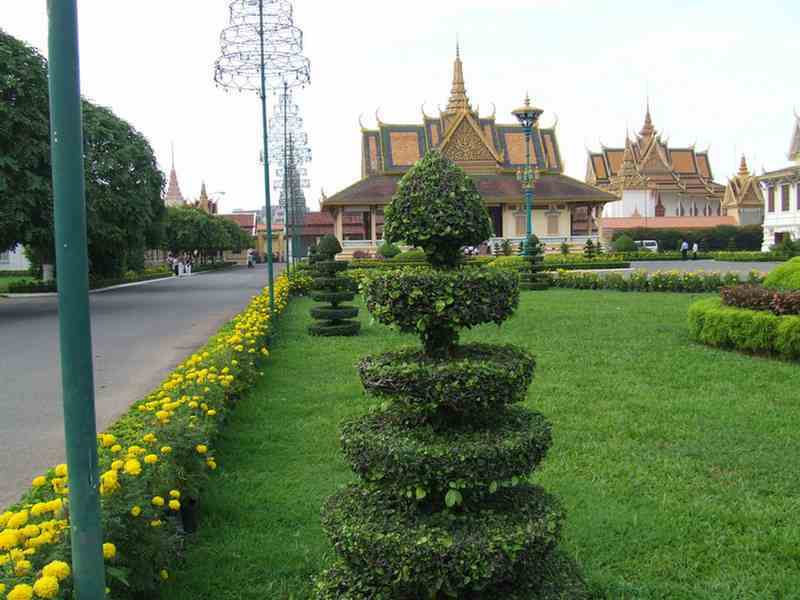
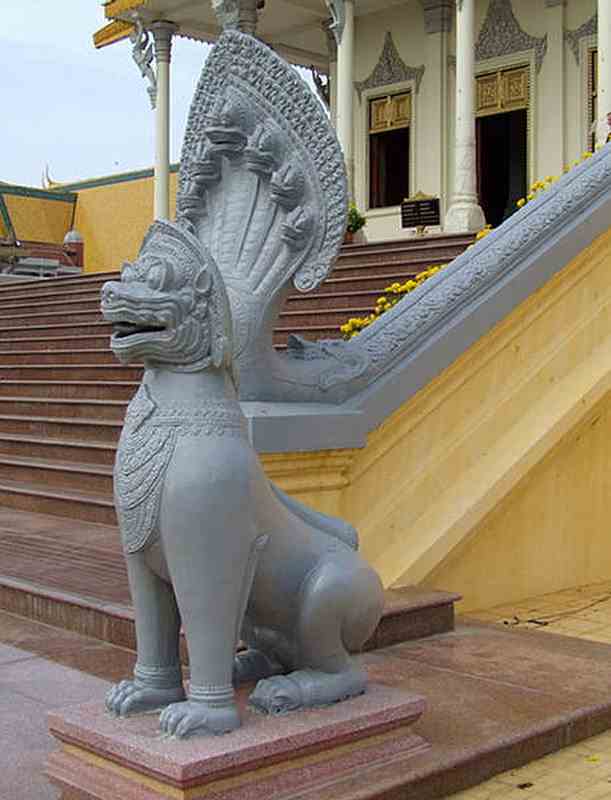
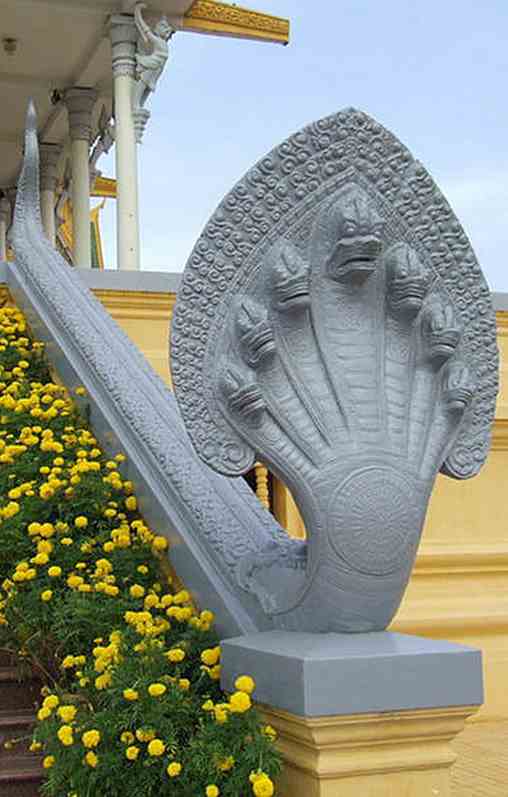
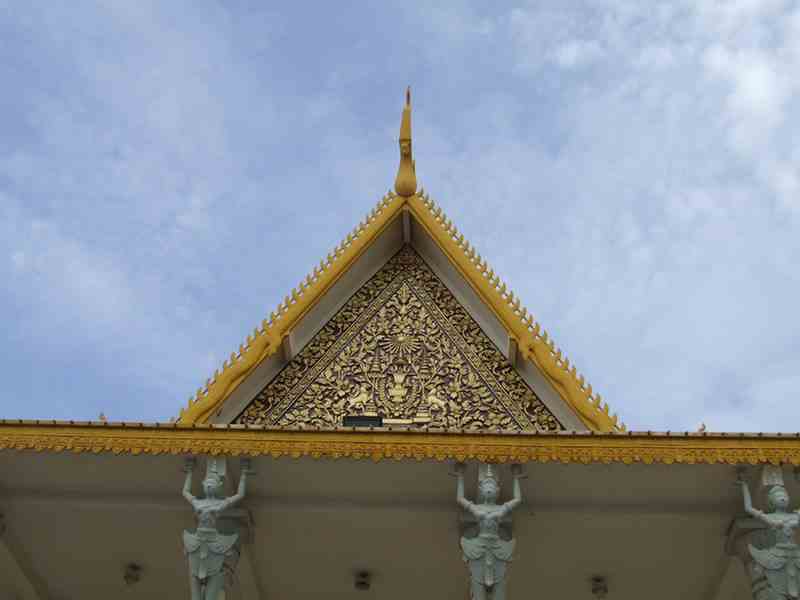
Some of the garden's shrubs would make a coiffed French poodle green with envy
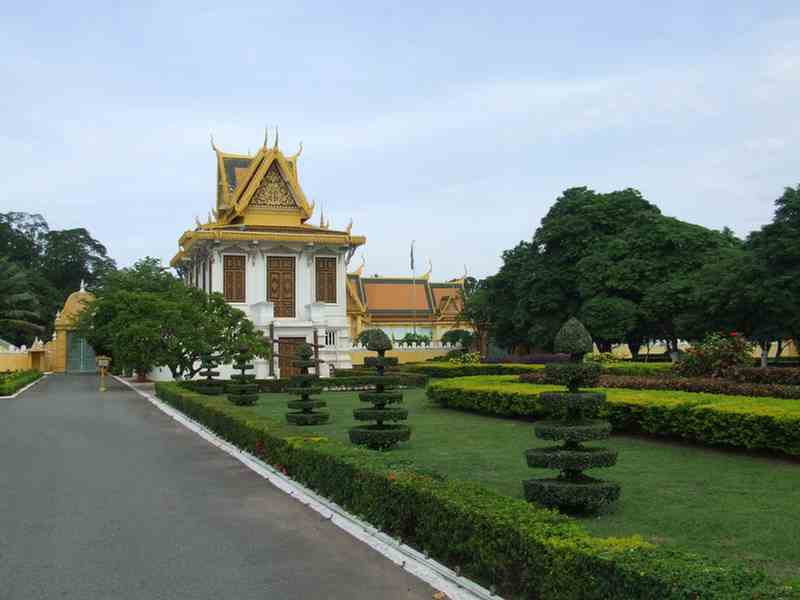

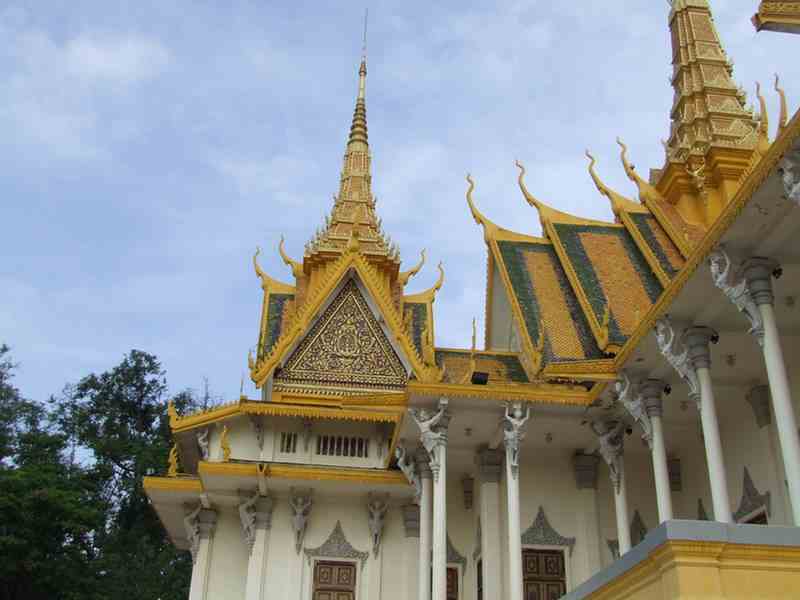
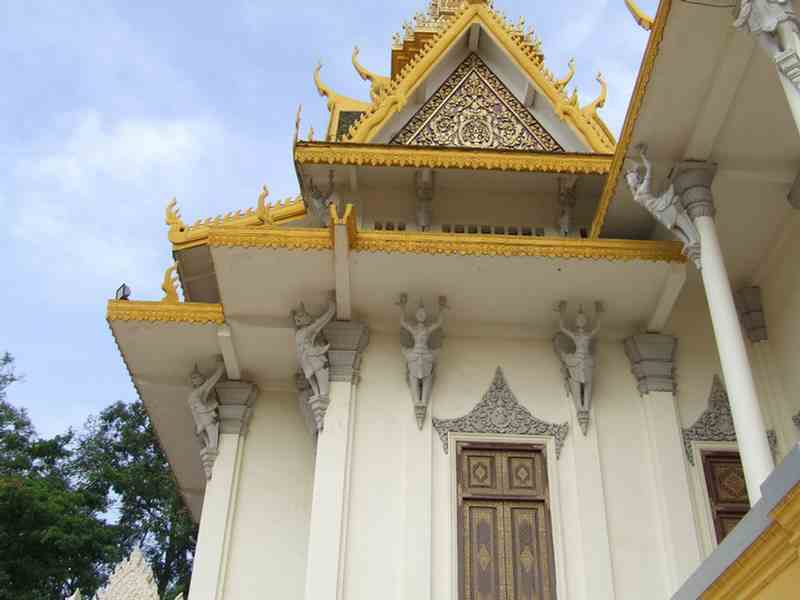
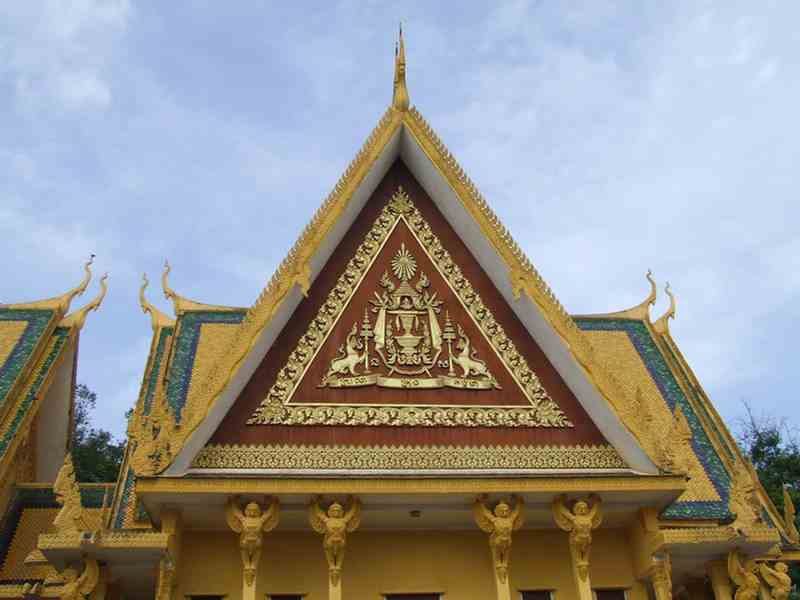
Out of character is the Napoleon III Pavilion. Constructed in 1876, it was originally built for
French Empress Eugenias, wife of Napoleon III, to use in the inauguration of the Suez Canal.
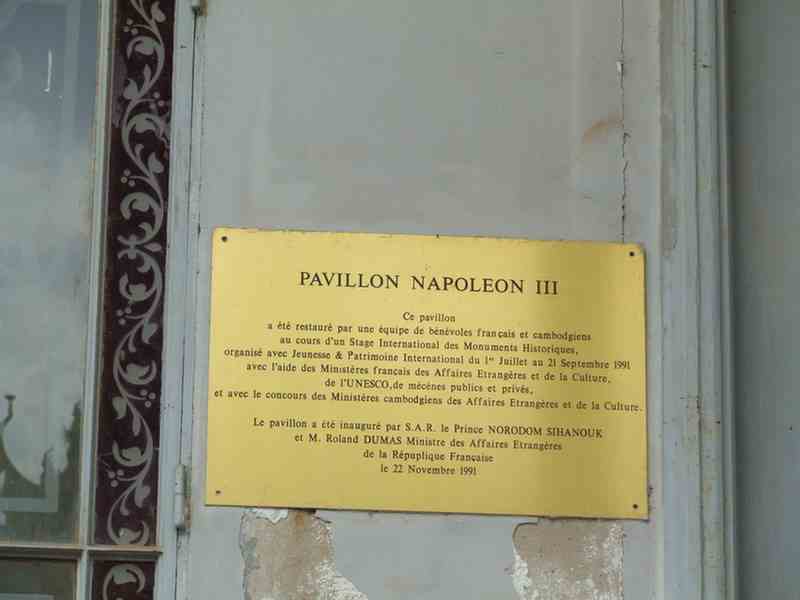
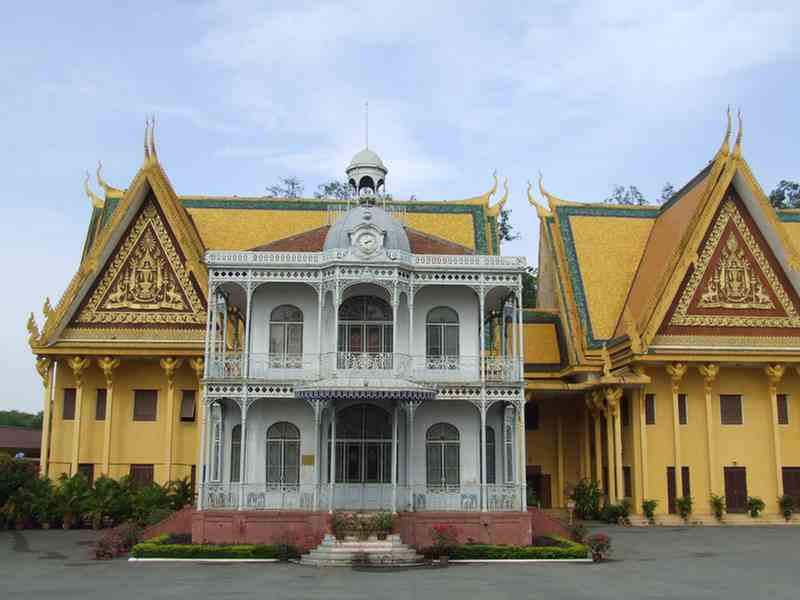
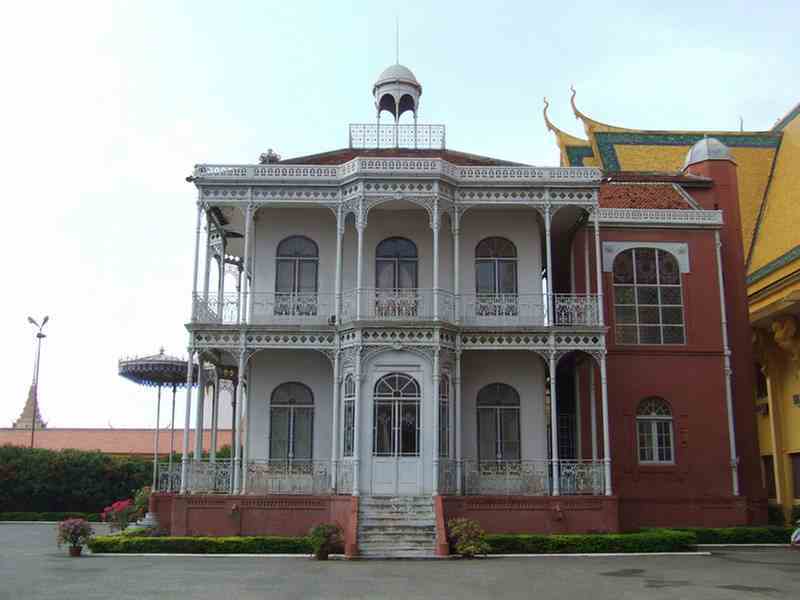
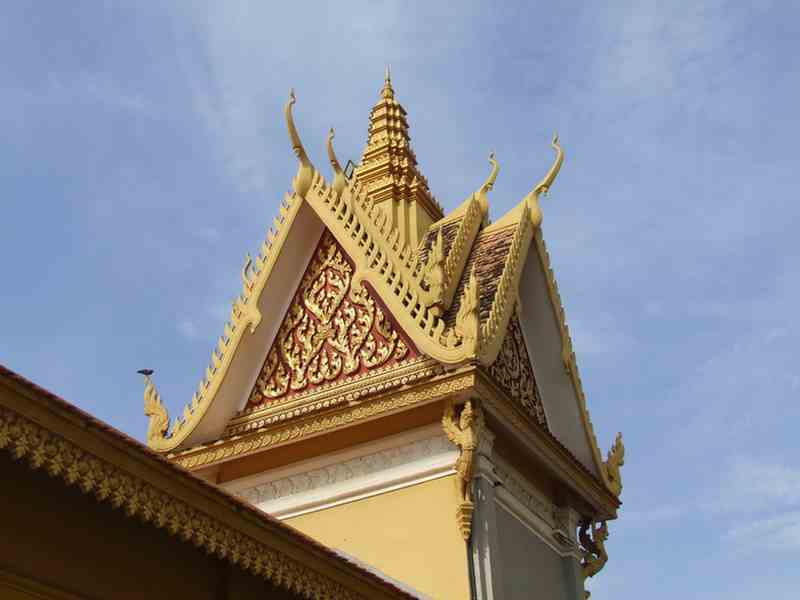
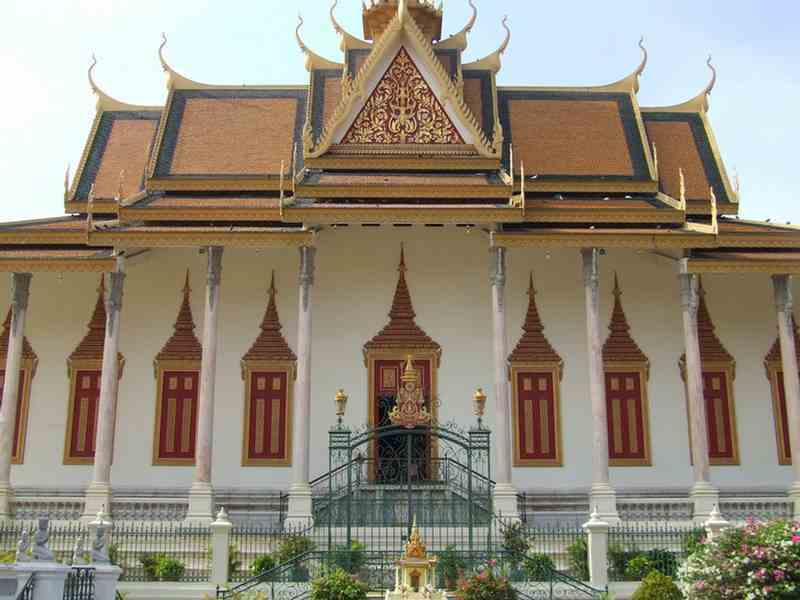
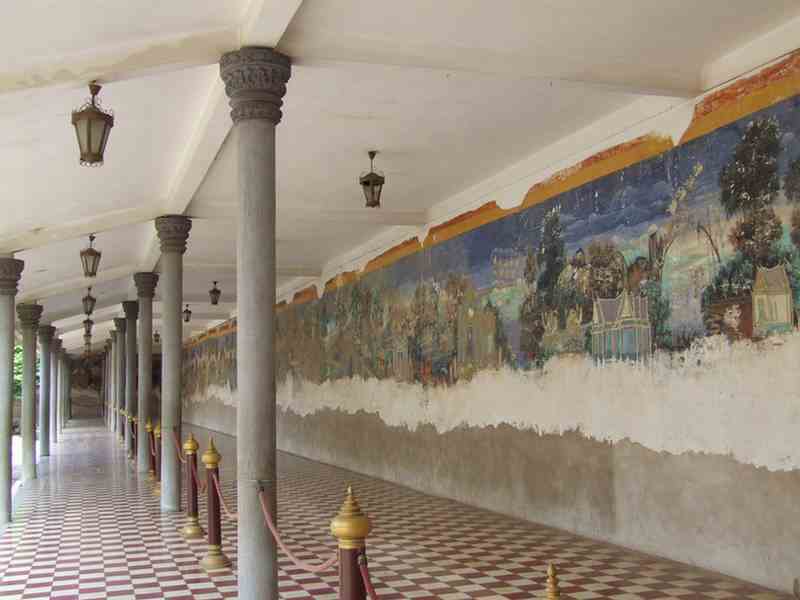
The Silver Pagoda houses many national treasures such as gold and jeweled Buddha statues.
Most notable is a small 17th century baccarat crystal Buddha (the "Emerald Buddha" of Cambodia)
and a near-life-size, Maitreya Buddha encrusted with 2,086 diamonds dressed in royal regalia
commissioned by King Sisowath.
During King Norodom Sihanouk's pre-Khmer Rouge reign, the Silver Pagoda was inlaid with more
than 5,329 silver tiles and some of its outer facade was remodelled with Italian marble.
Most of the the silver tiles on the floor were covered with carpet.
However there were areas where you could see the beautifully etched tiles.
It is the most notable Wat in the Phnom Penh, and the official temple of the King of Cambodia.
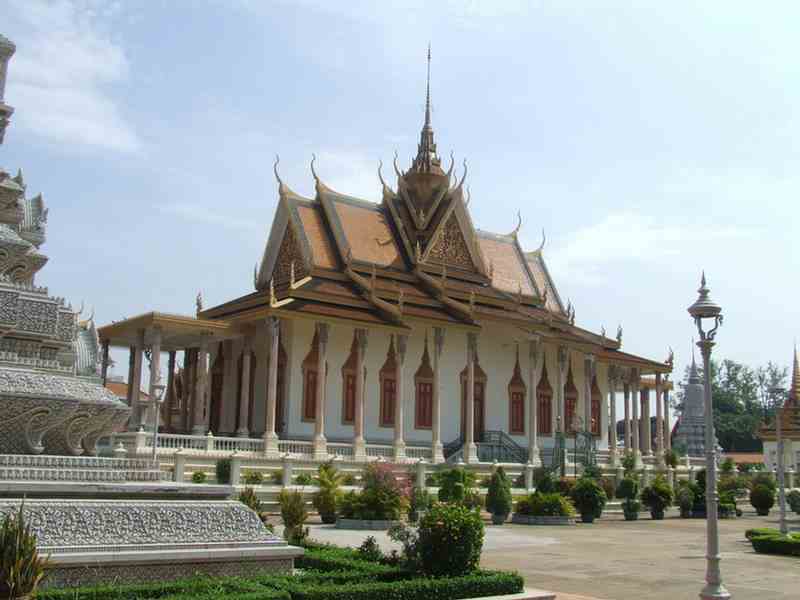
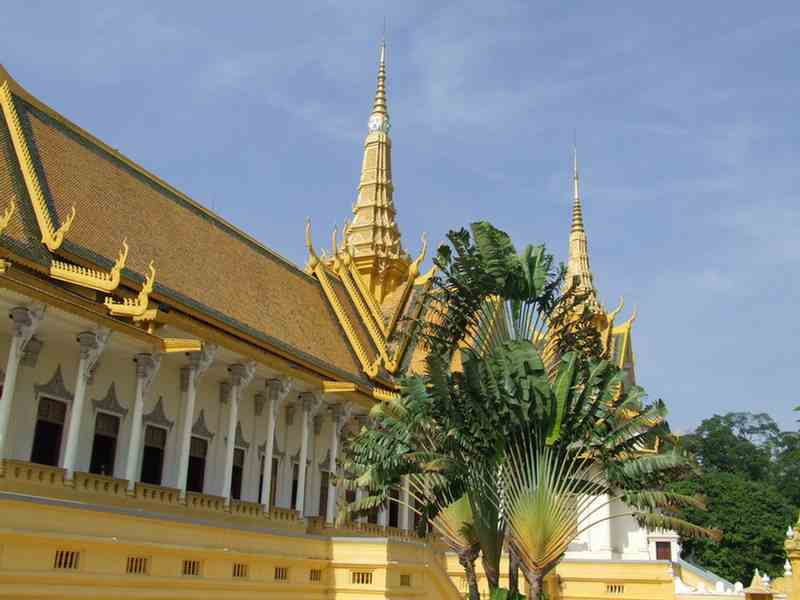
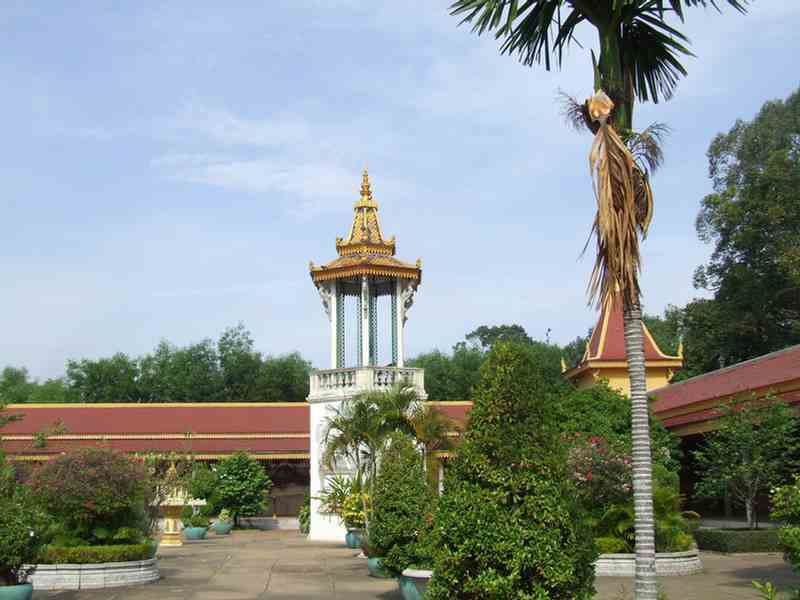
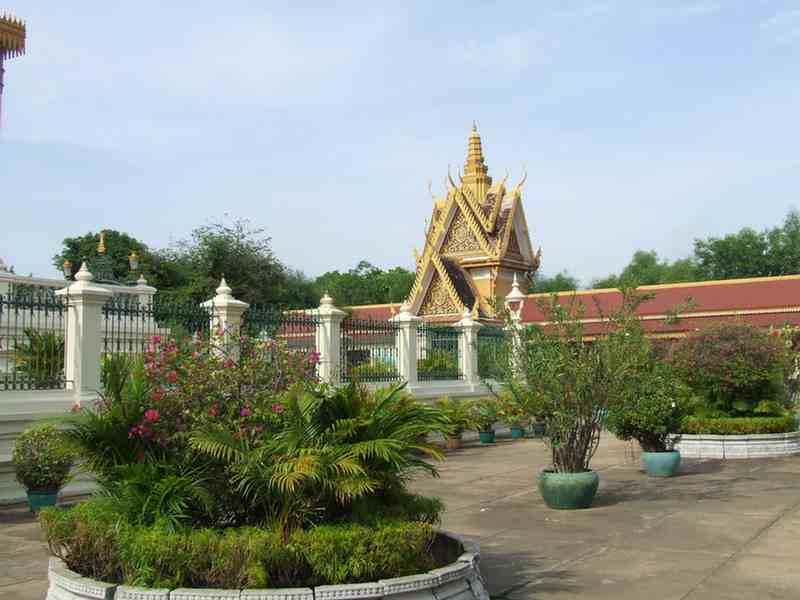
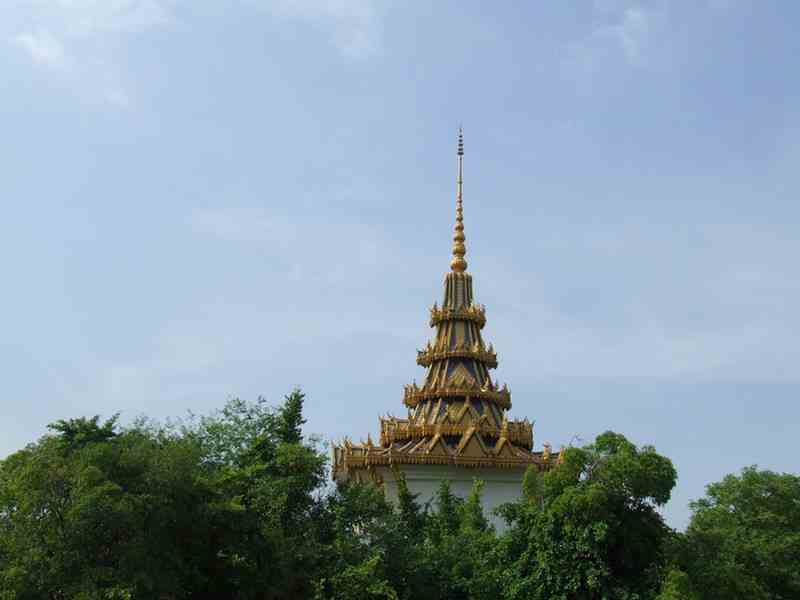
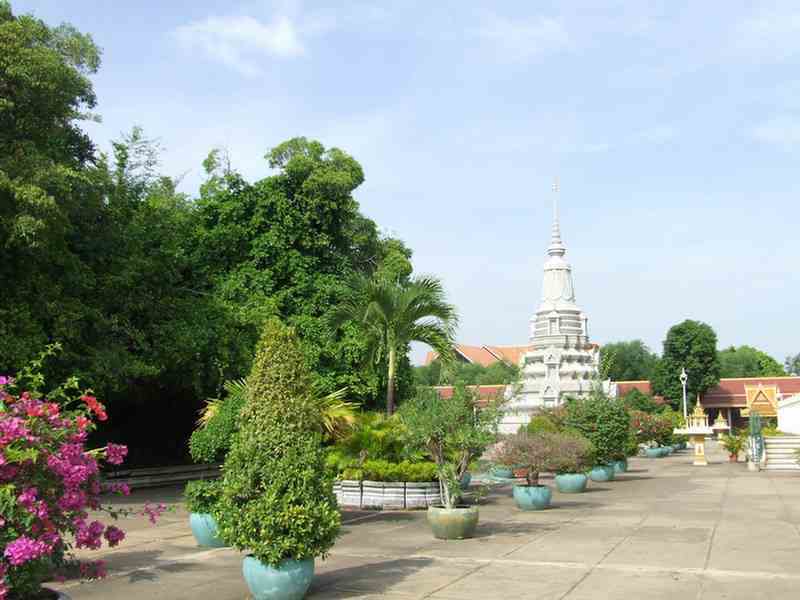
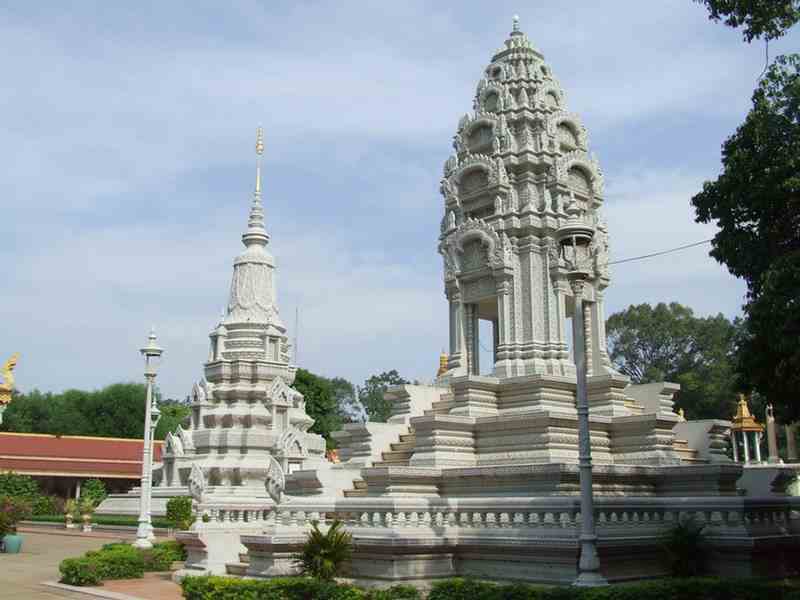
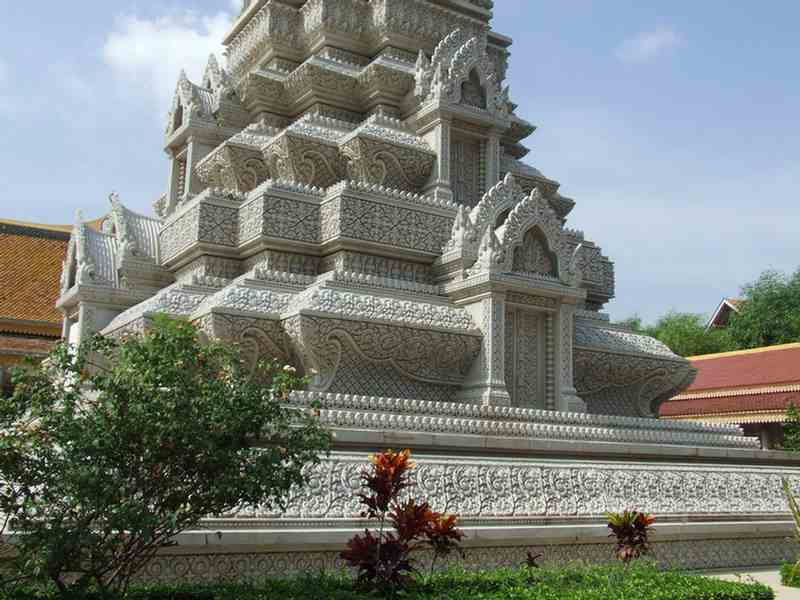
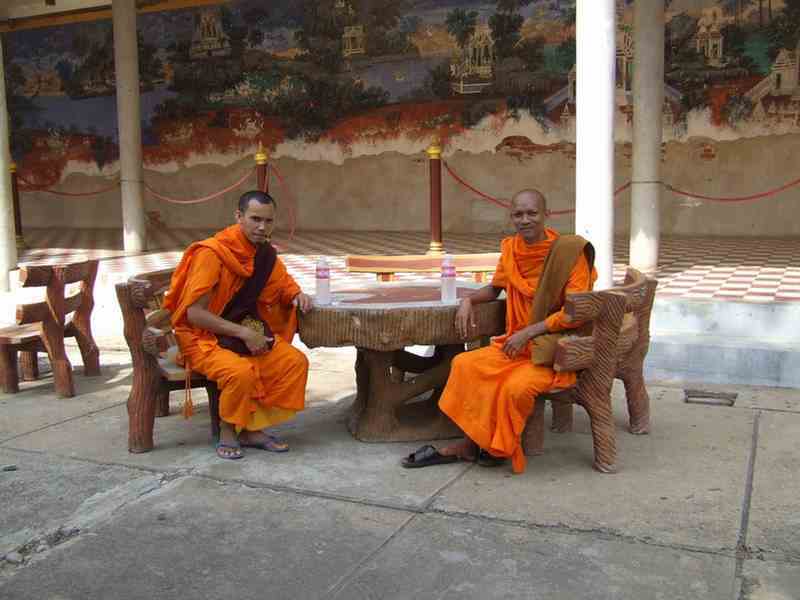
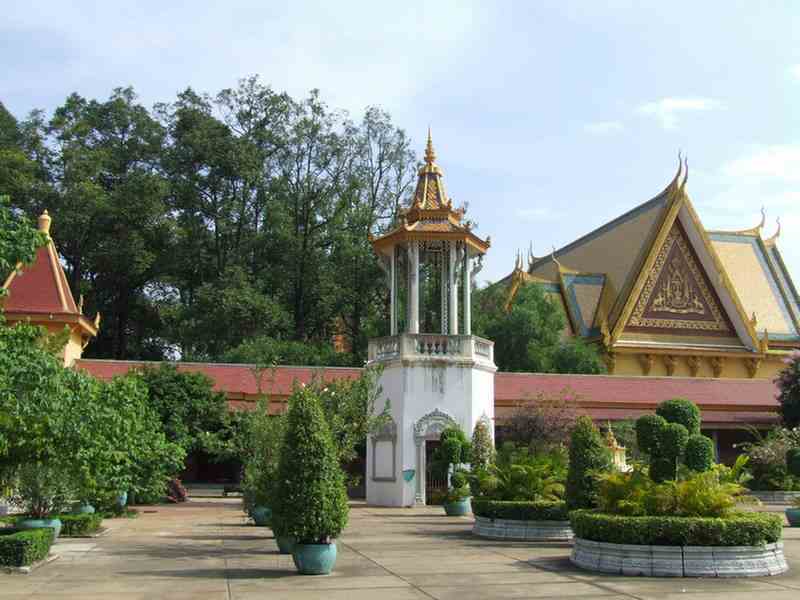
The pavilion from where the royals mounted the royal elephants
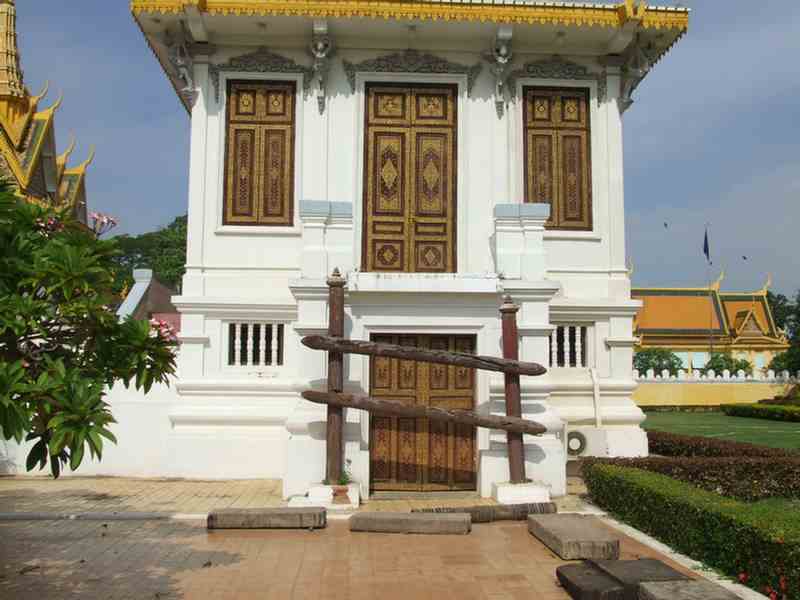
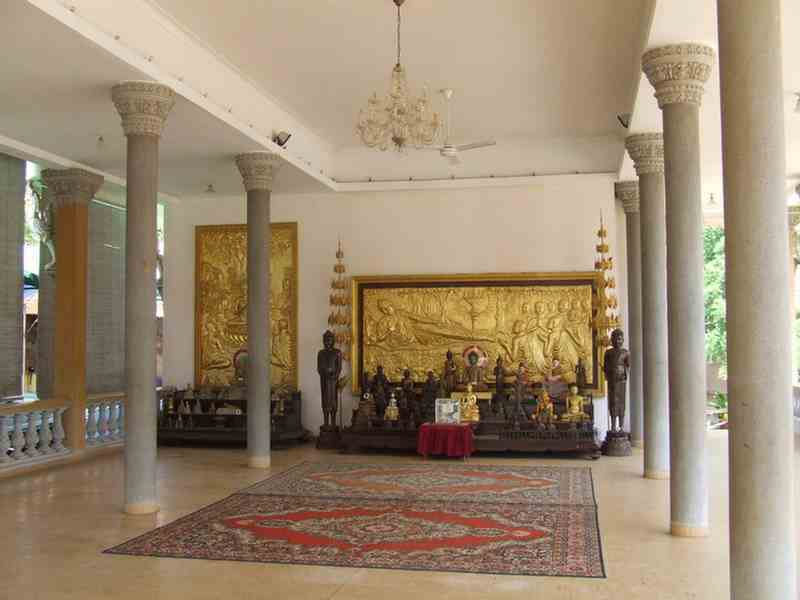
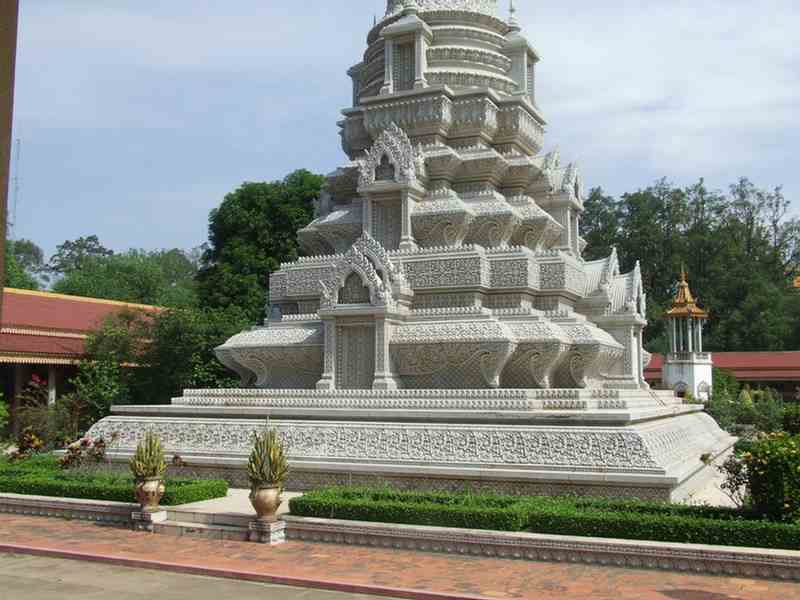

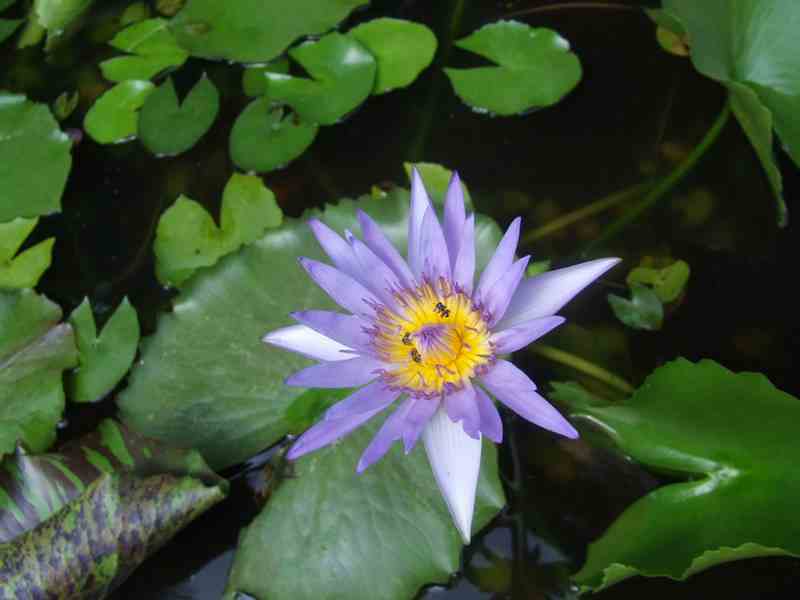
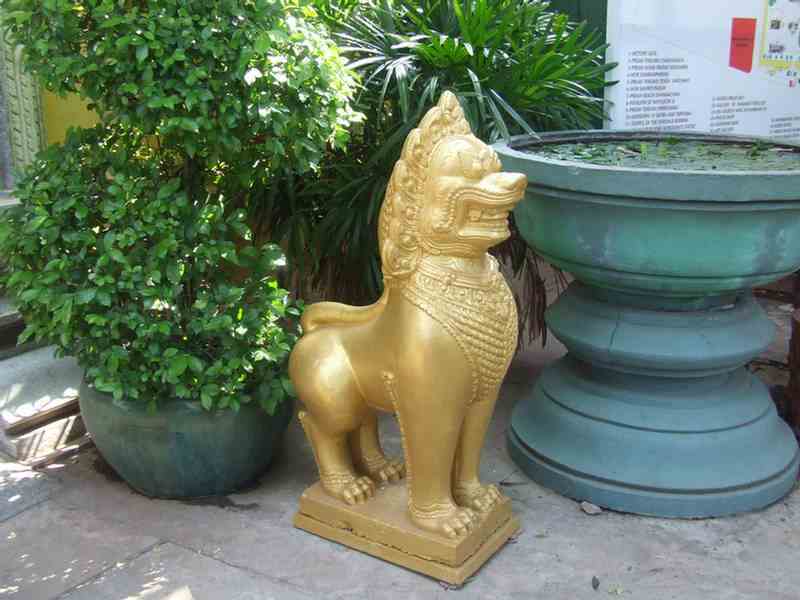
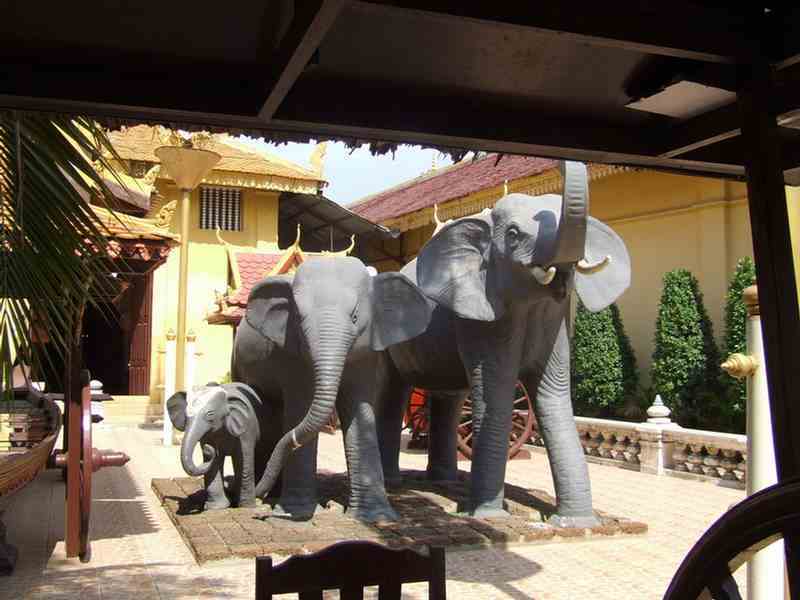
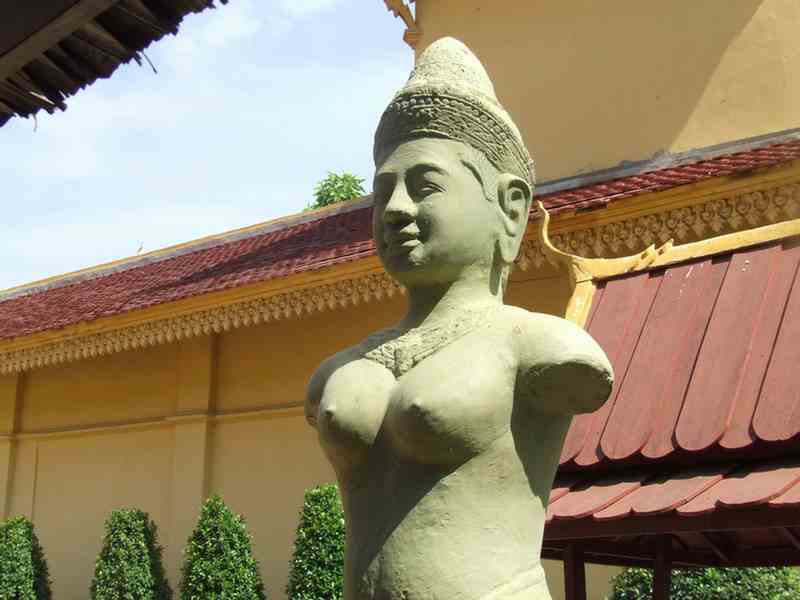
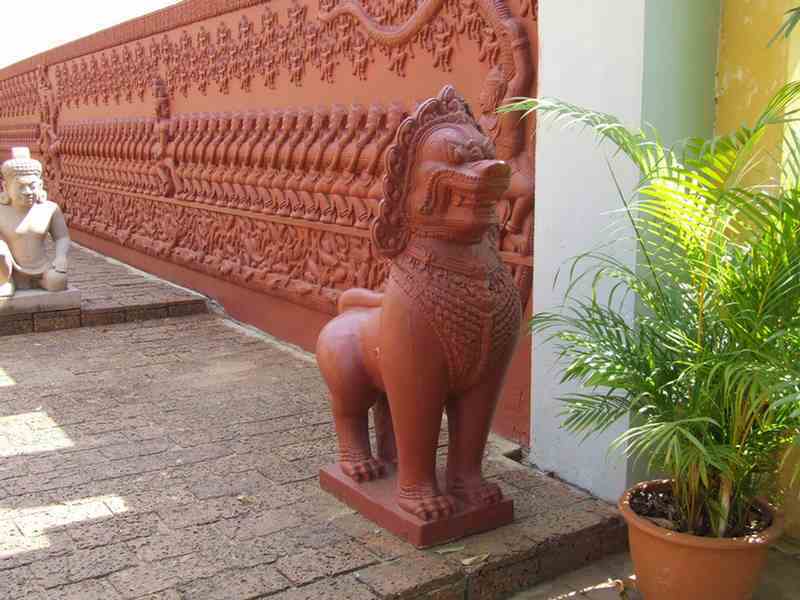
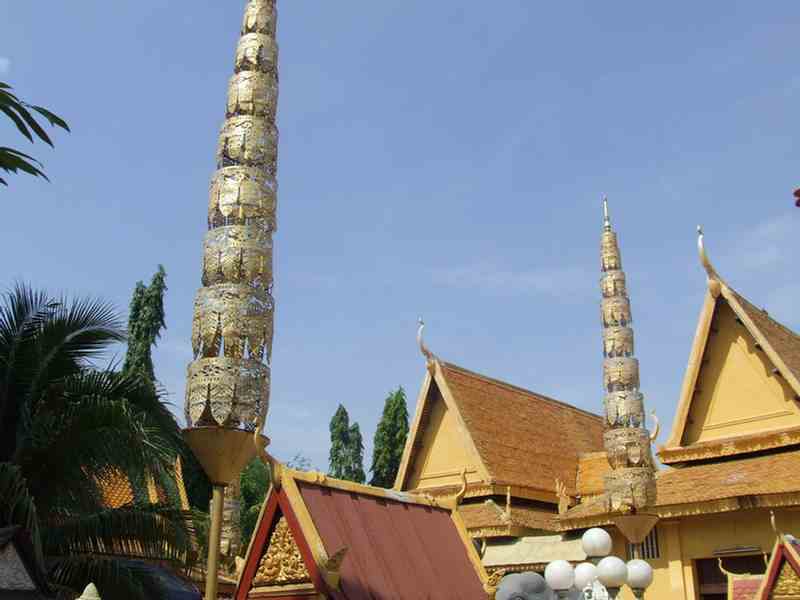
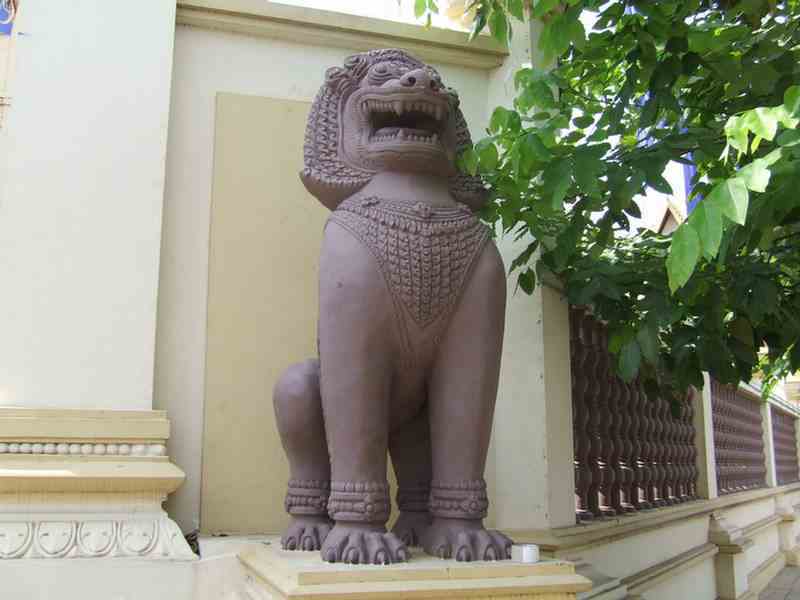
The National Museum
The National Museum is near the Royal Palace but was a bit hard to find.
This distinctive rust-coloured building in traditional Khmer style was inaugurated in 1920 by King Sisowat.
The roof space is home to the largest bat colony in the world living in an artificial structure.
Every evening these bats flock out of the roof and swarm around in the sky before searching for food.
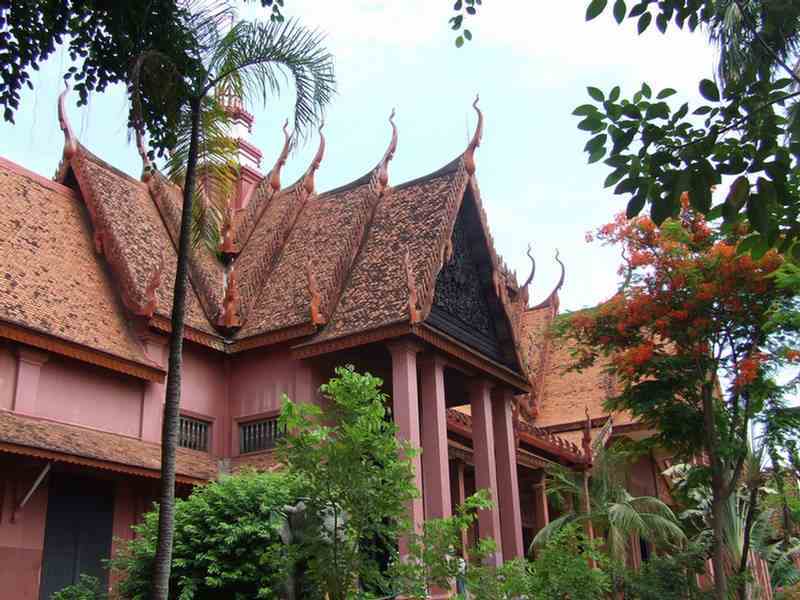
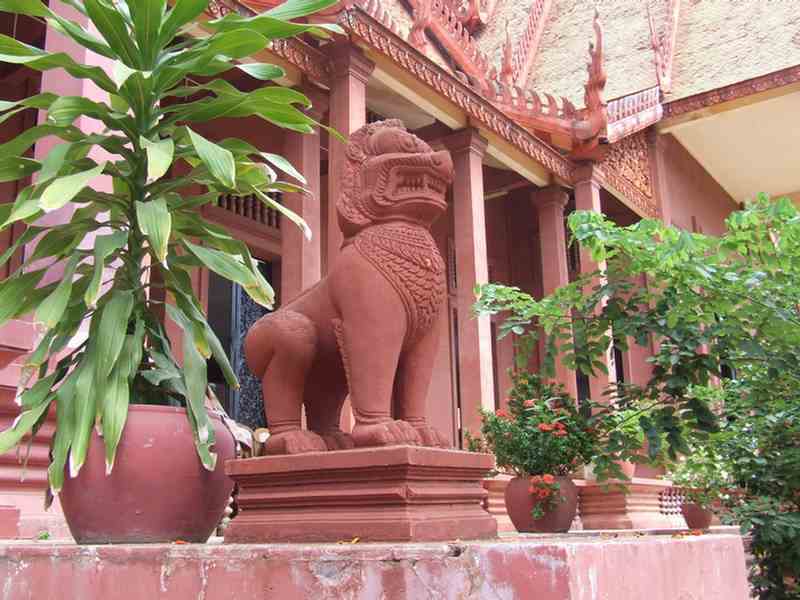
I made some new friends here.
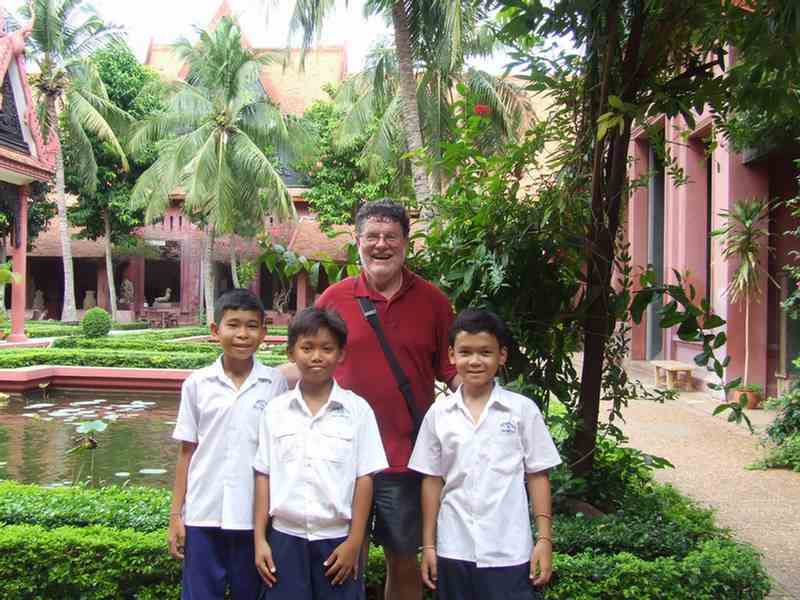
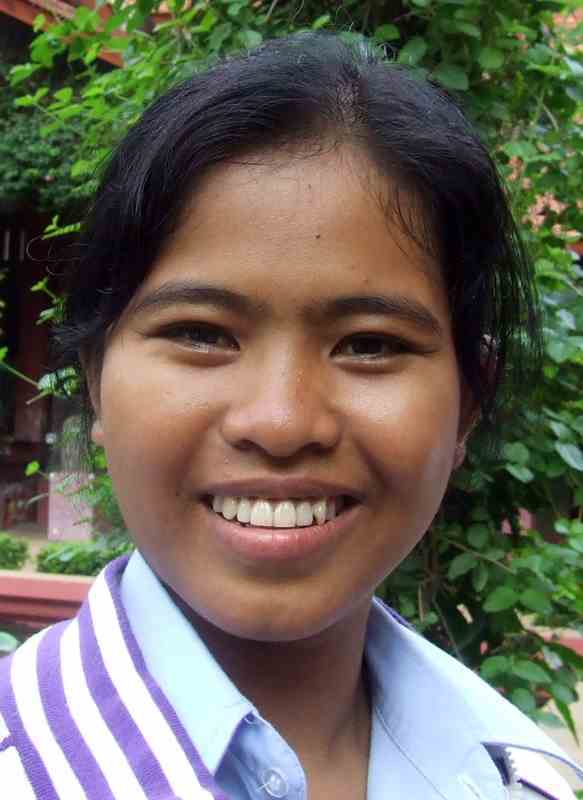
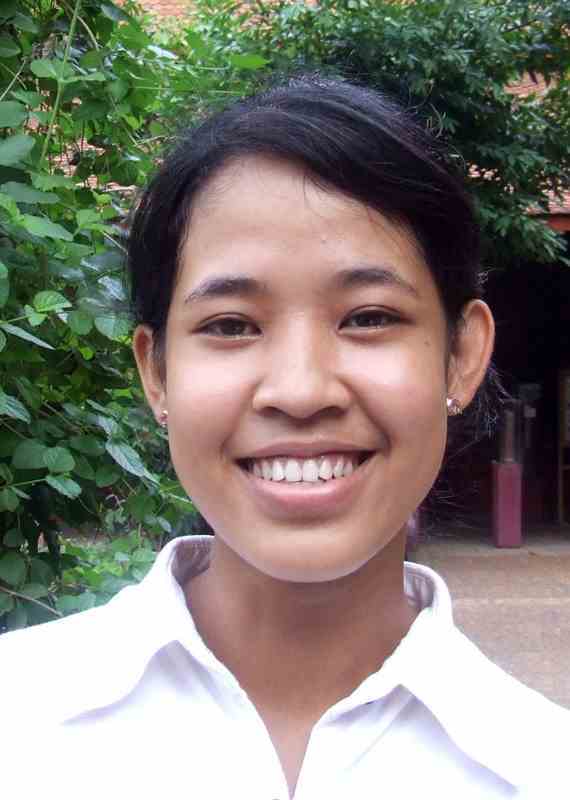
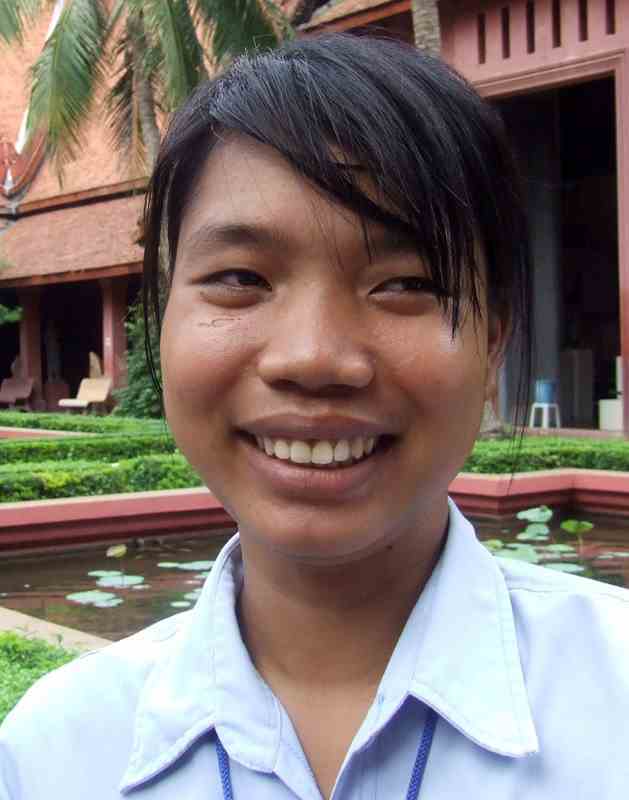
Some friendly university students.
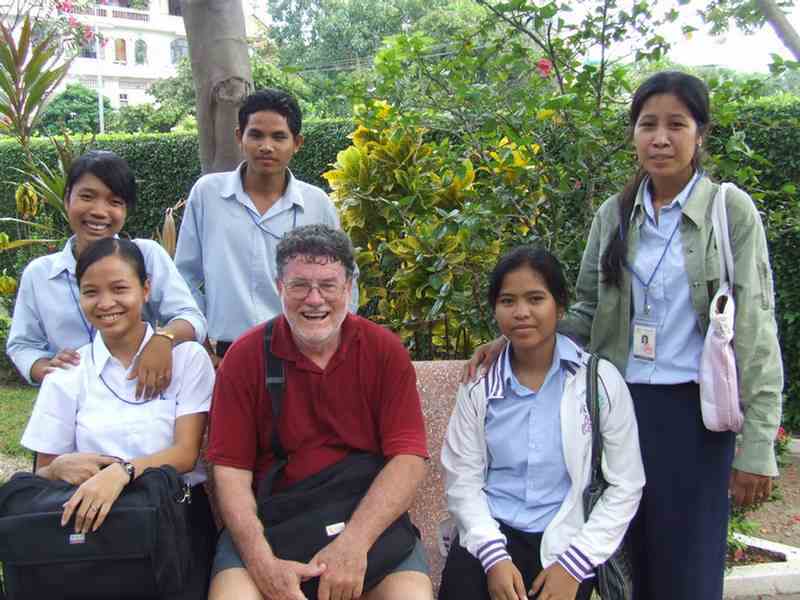
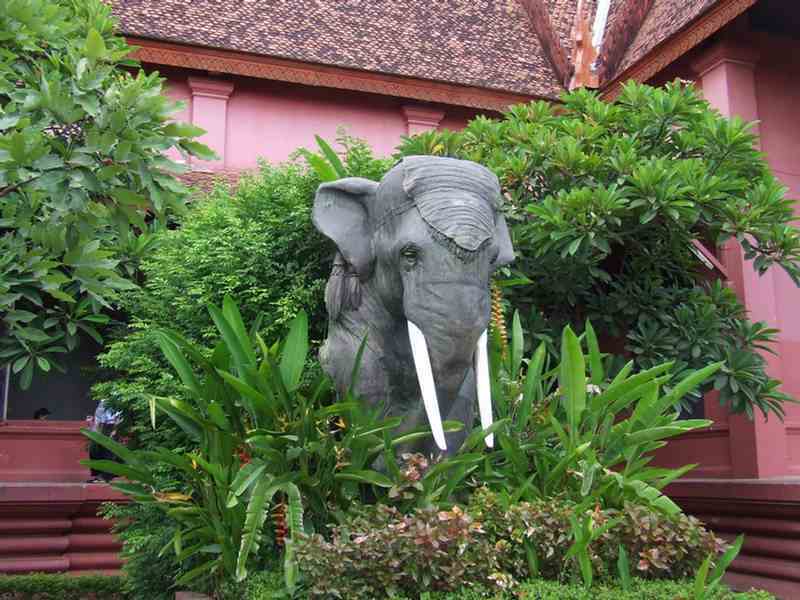
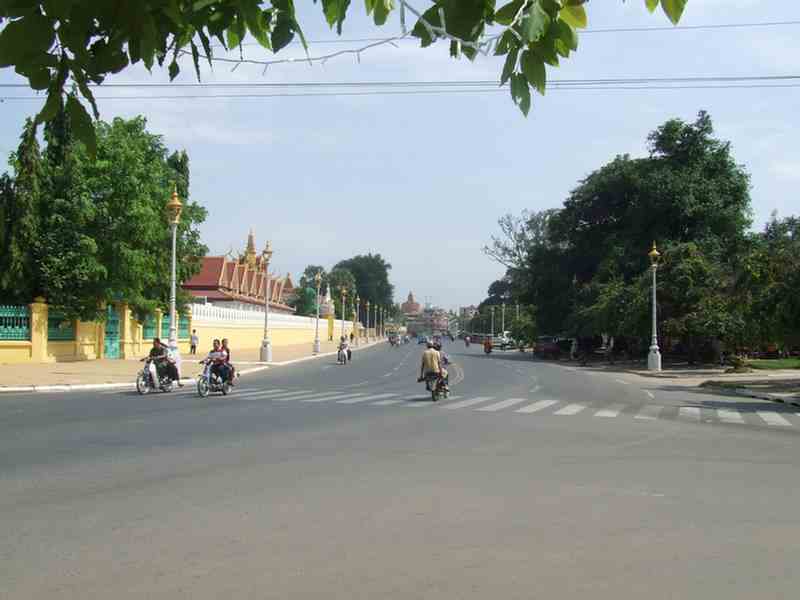
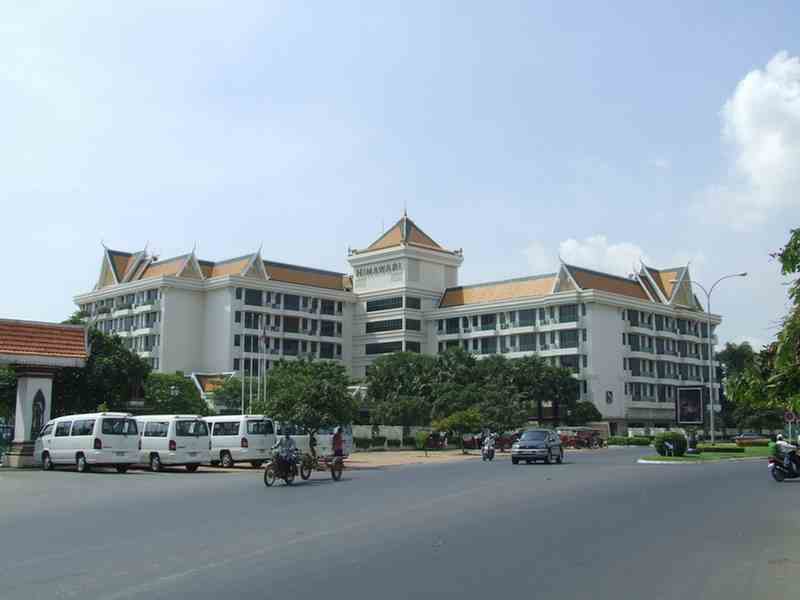
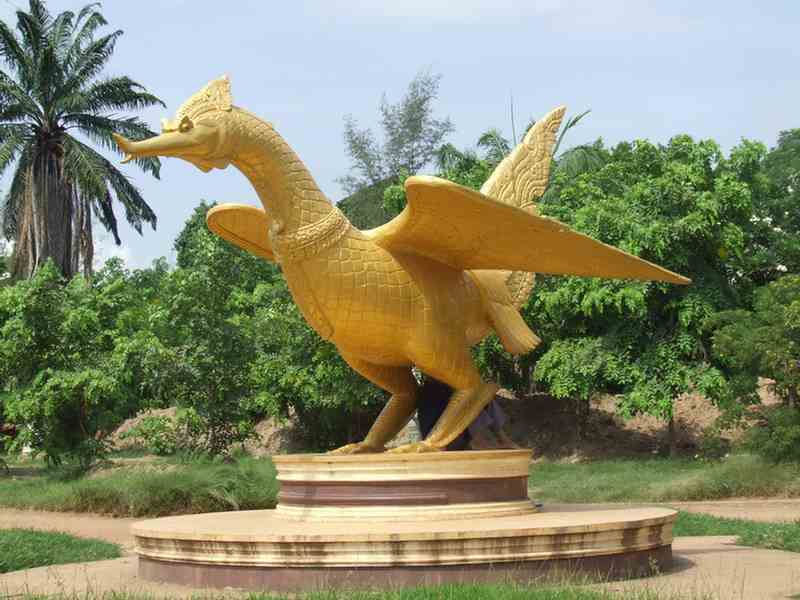
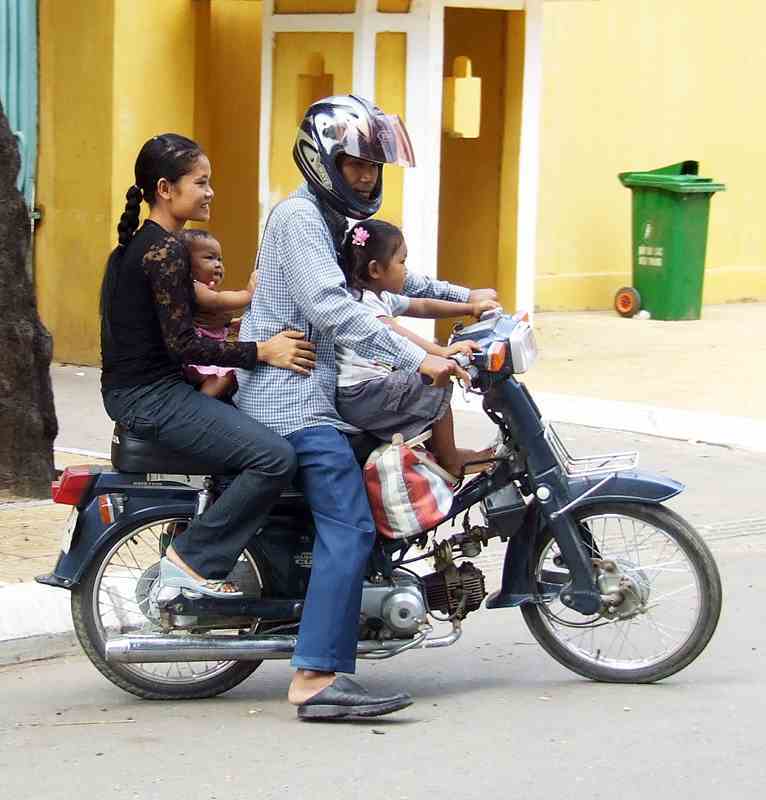
The Independence Monument is a single tower of Angkorian style, standing in the heart of the capital.
It was built in 1958 to celebrate Cambodian Independence from France on the 9th November 1953.
Today, it also serves as a monument to Cambodia’s war dead.
Its unique look distinguishes it from all the other structures in the city,
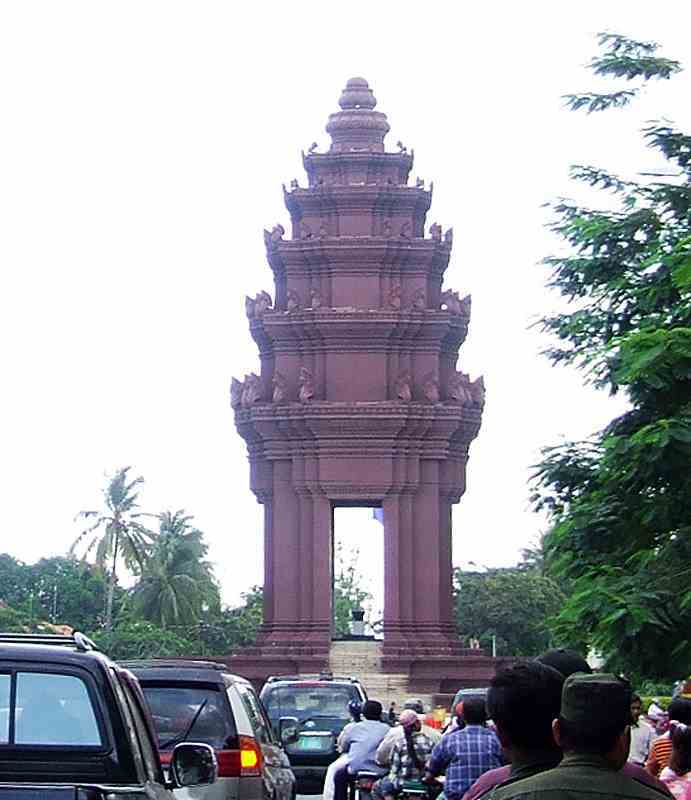
Doing you homework on the way to school - Cambodian style
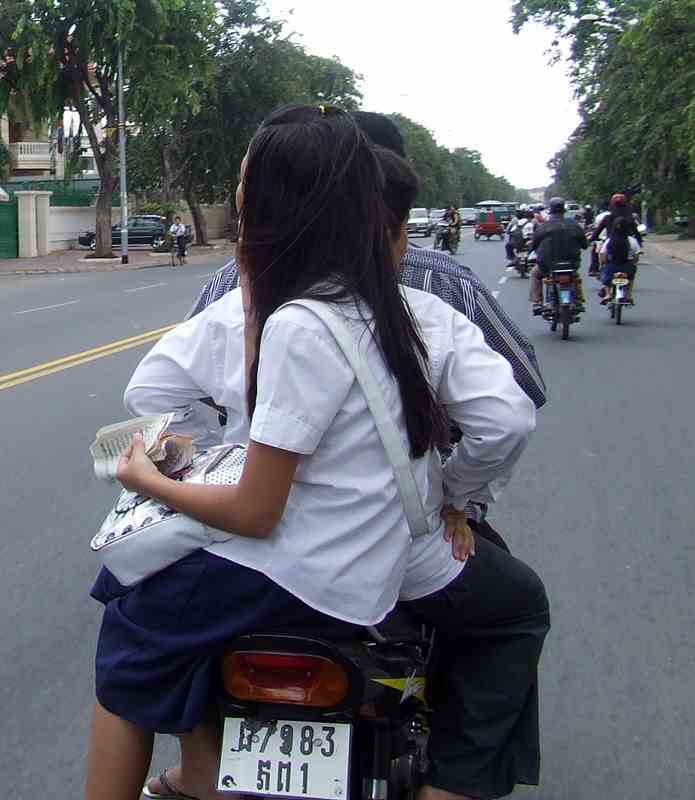
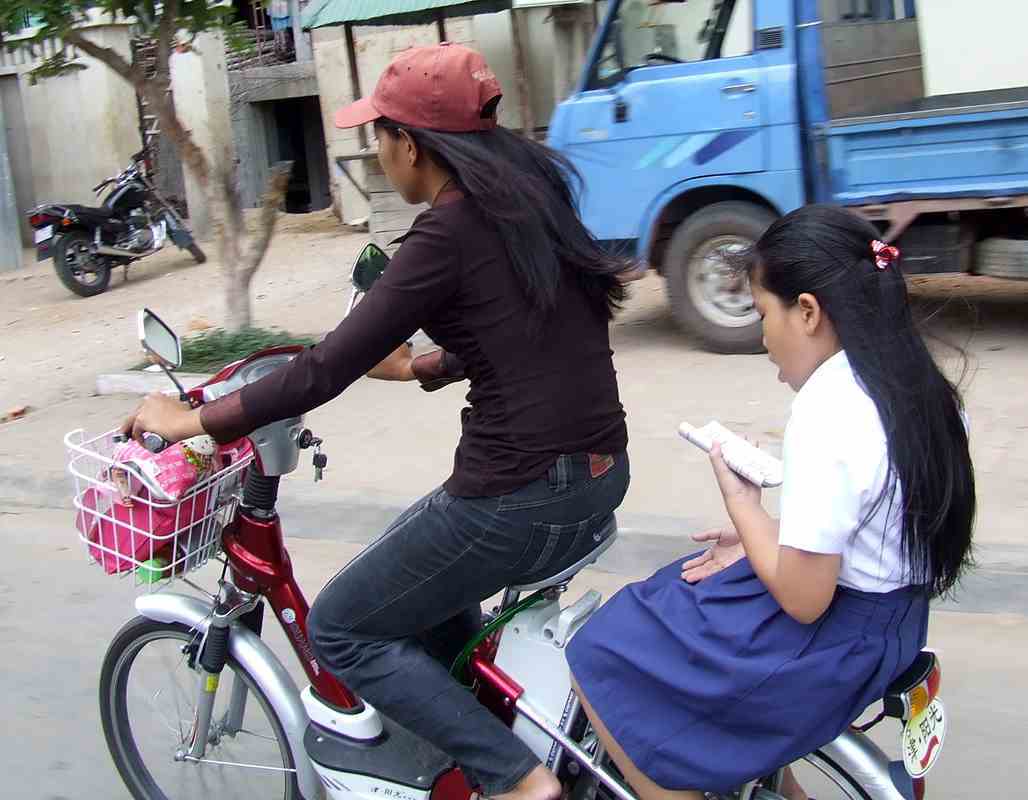
Toul Sleng Genocide Museum
The site is a former high school which was used as the notorious Security Prison 21 (S-21) by the Khmer Rouge regime
from its rise to power in 1975 to its fall in 1979.
Tuol Sleng in Khmer means "Hill of the Poisonous Trees" or "Strychnine Hill".
From 1975 to 1979, an estimated 17,000 people were imprisoned at Tuol Sleng.
The prisoners were selected from all around the country, and usually were former
Khmer Rouge members and soldiers, accused of betraying the party or revolution.
Those arrested included some of the highest ranking communist politicians.
Although the official reason for their arrest was "espionage," these men may have been viewed by
Khmer Rouge leader Pol Pot as potential leaders of a coup against him.
Even though the vast majority of the victims were Cambodian, foreigners were also imprisoned and executed.
Formerly the Tuol Svay Prey High School, named after a Royal ancestor of King Norodom Sihanouk,
the five buildings of the complex were converted in August 1975, four months after the Khmer Rouge won the civil war,
into a prison and interrogation centre.
The Khmer Rouge renamed the complex "Security Prison 21" (S-21) and construction began to adapt the prison to the inmates.
The buildings were enclosed in electrified barbed wire, the classrooms converted into tiny prison and torture chambers,
and all windows were covered with iron bars and barbed wire to prevent escapes.
Most prisoners at S-21 were held there for two to three months.
However, several high-ranking Khmer Rouge cadres were held longer.
Within two or three days after they were brought to S-21, all prisoners were taken for interrogation.
For the first year of S-21’s existence, corpses were buried near the prison.
However, by the end of 1979, cadres ran out of burial spaces, the prisoner and their family were taken
to the Choeung Ek extermination center (The Killing Fields), fifteen kilometers from Phnom Penh.
In 1979, the prison was uncovered by the invading Vietnamese army. In 1980, the prison was reopened as a historical
museum memorializing the actions of the Khmer Rouge regime.
Out of an estimated 17,000 people imprisoned at Tuol Sleng, there were only twelve known survivors.
One of them,Vann Nath, had trained as an artist and was put to work painting pictures of Pol Pot.
Many of his paintings depicting events he witnessed in Tuol Sleng are on display in the Tuol Sleng Genocide Museum today.
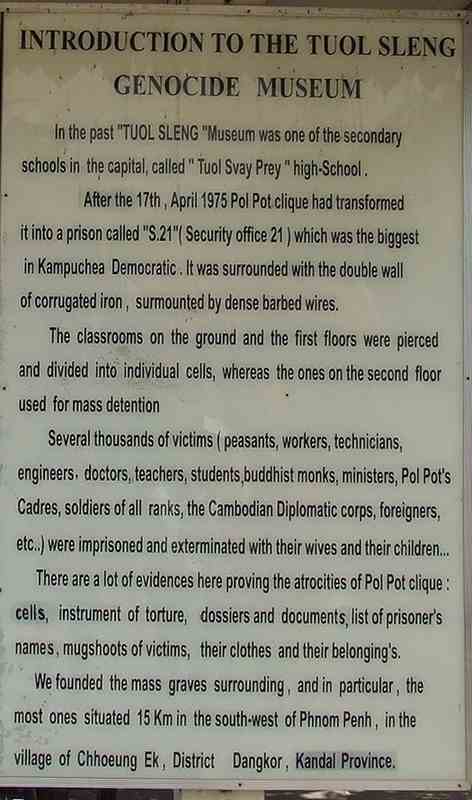
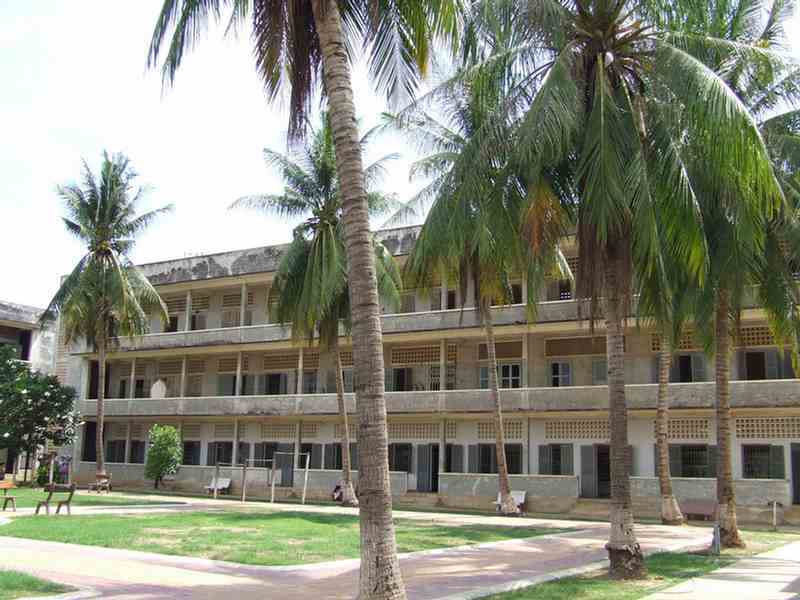
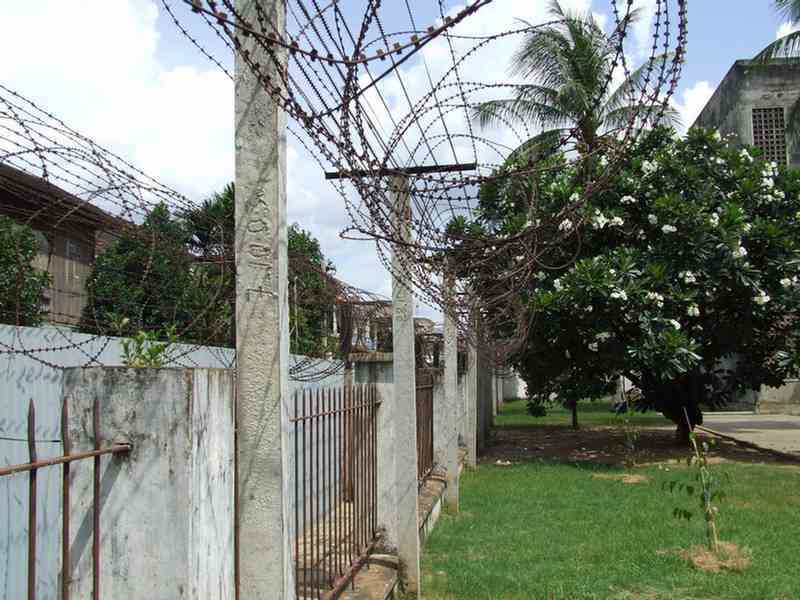
Our local guide, Ran, a 37 yo, was a boy during this time. He was an excellent guide.
His family lived near the Thai border but he lost his father and 3 siblings during the war.
His family set him off alone by himself, so that he appeared to be an orphan.
He worked in the rice fields.
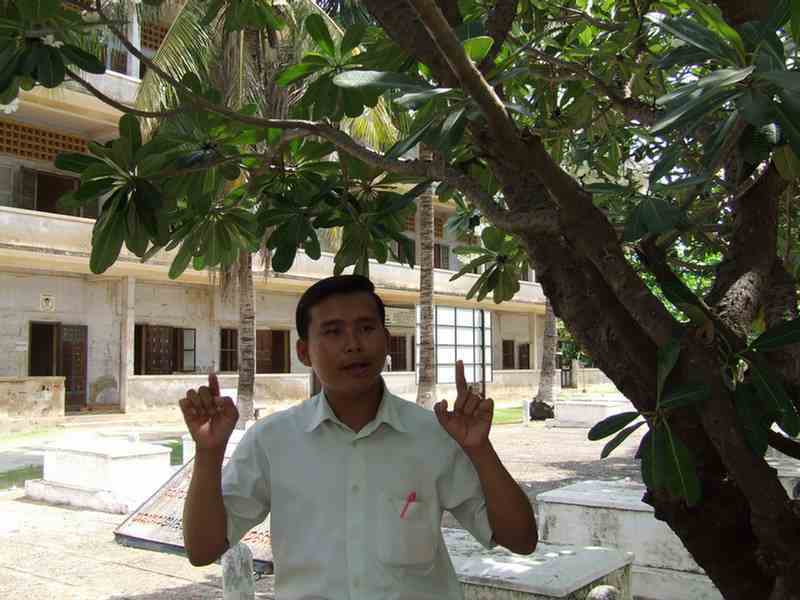
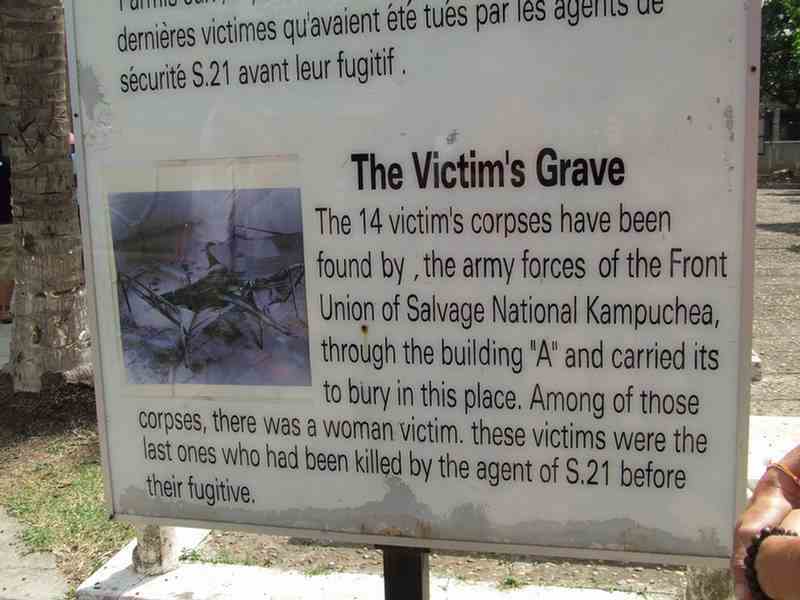
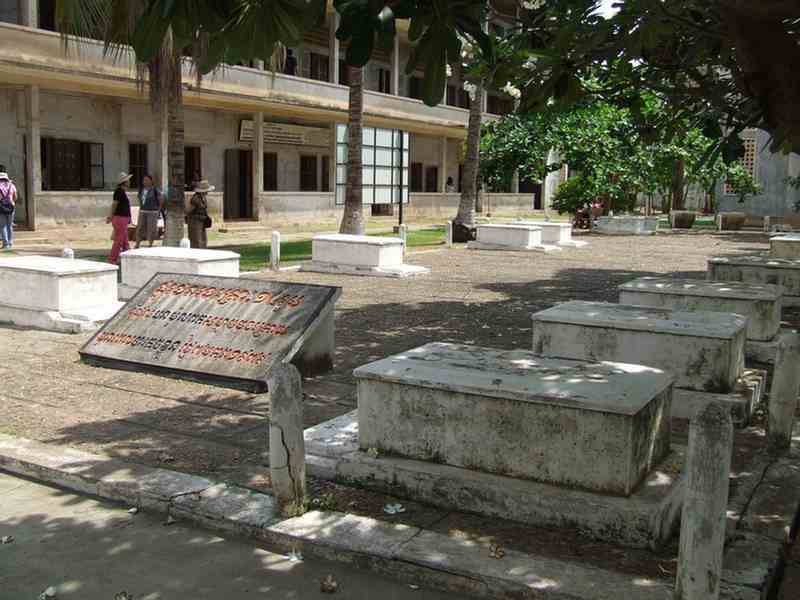
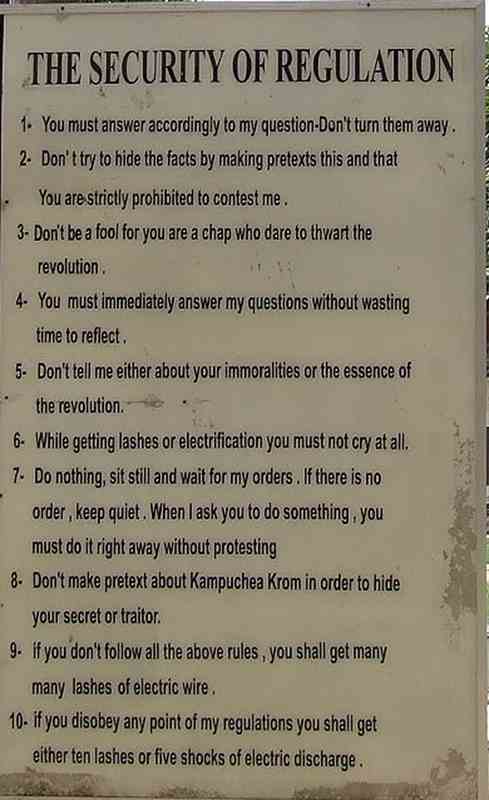
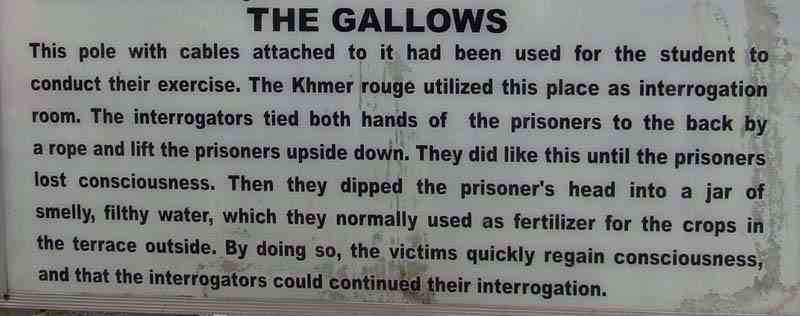
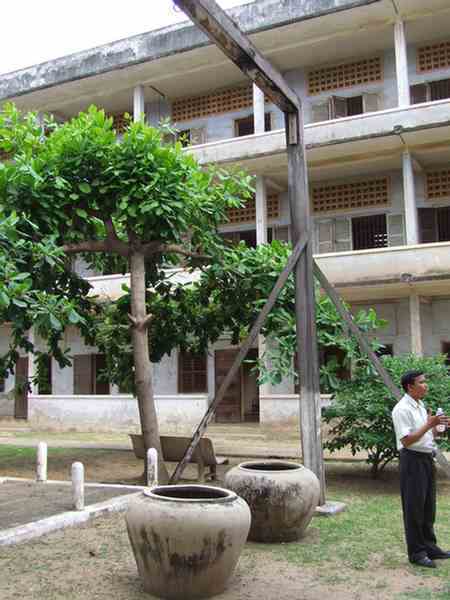
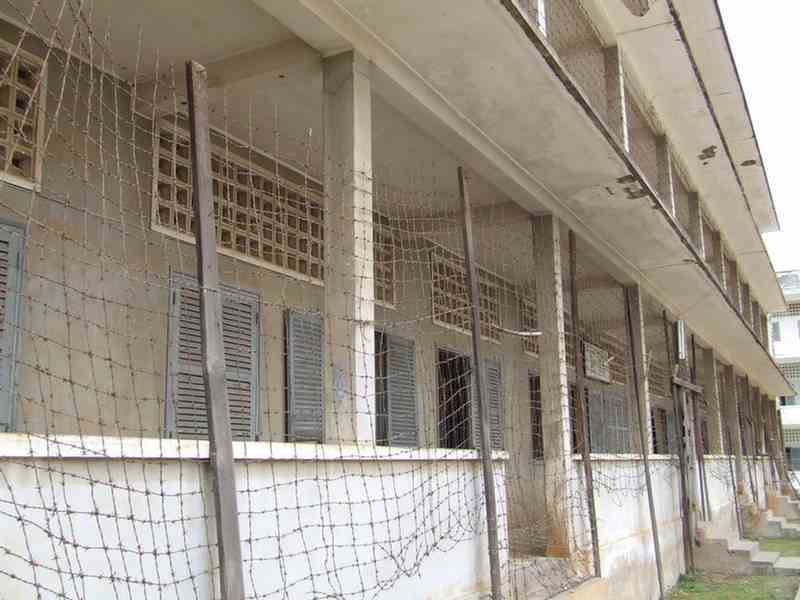
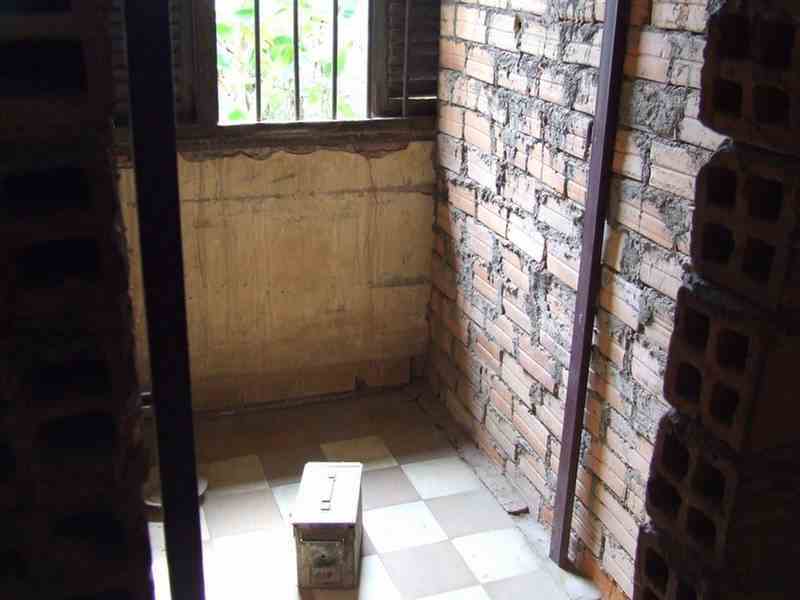
It appears like an electrical engineer was imprisoned in this room
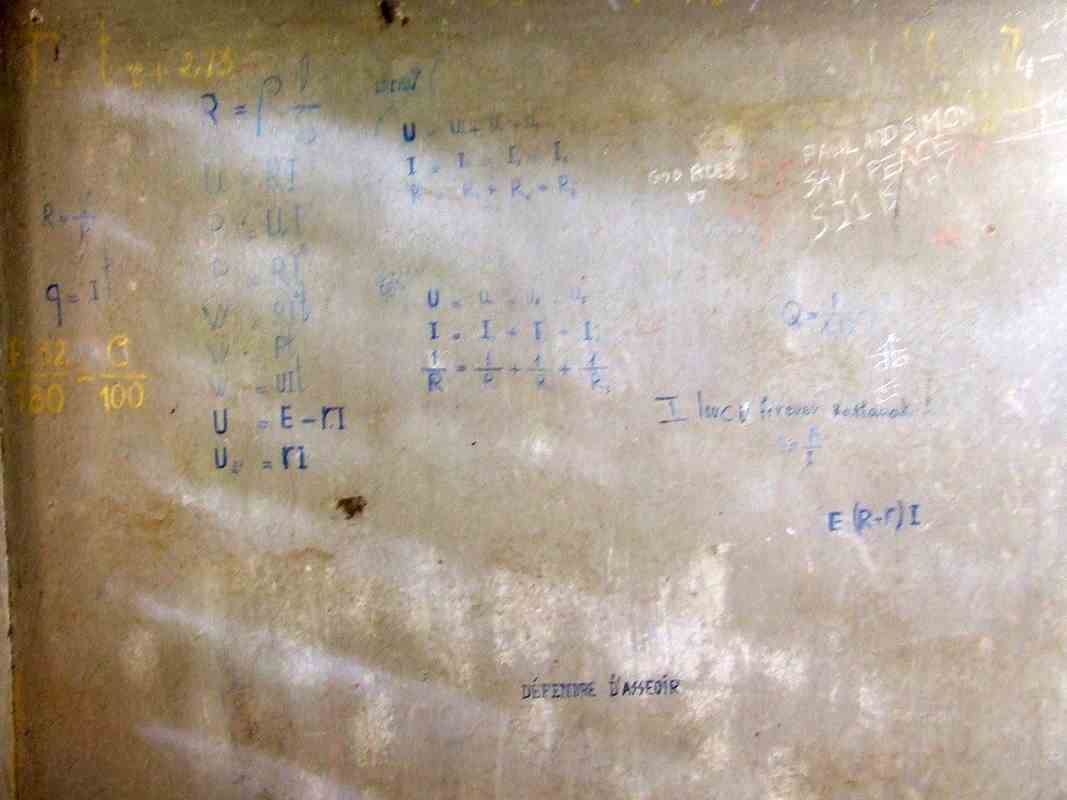
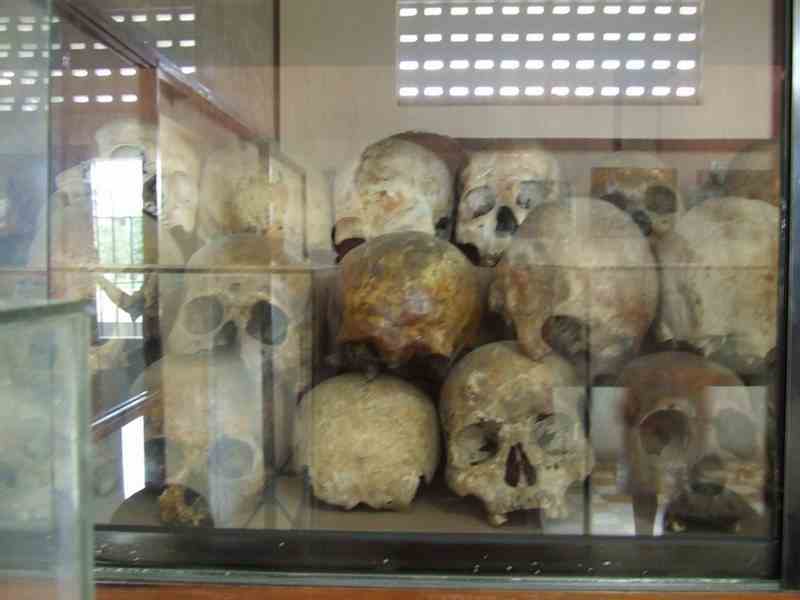
In the early days, detainees who died during torture, were buried here
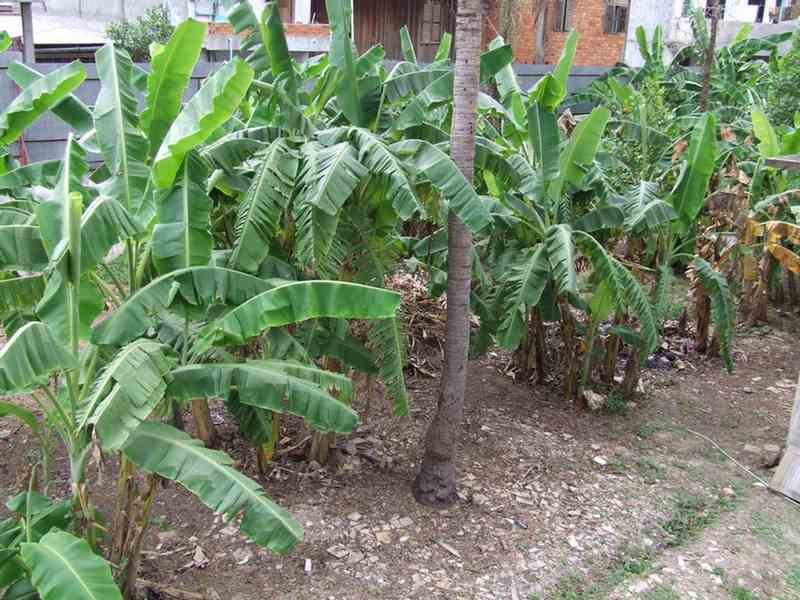
The blackboard is still in one of the former classrooms
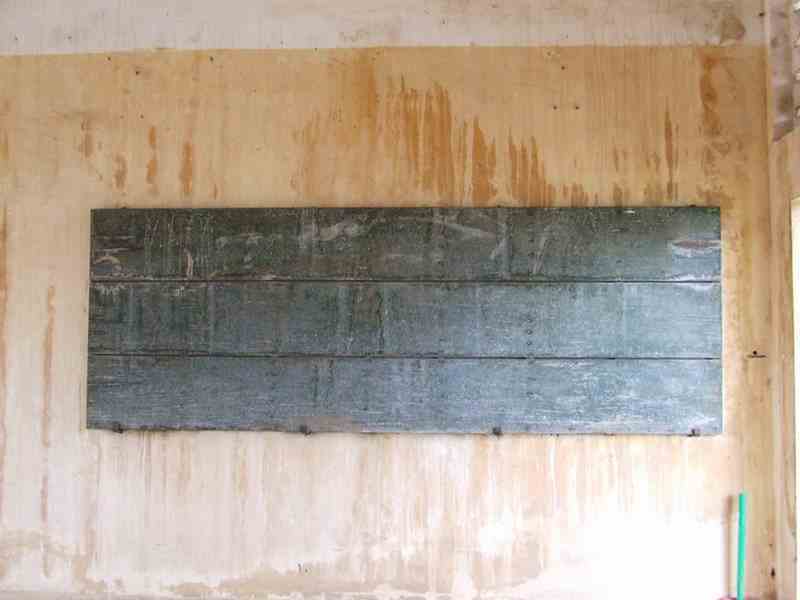
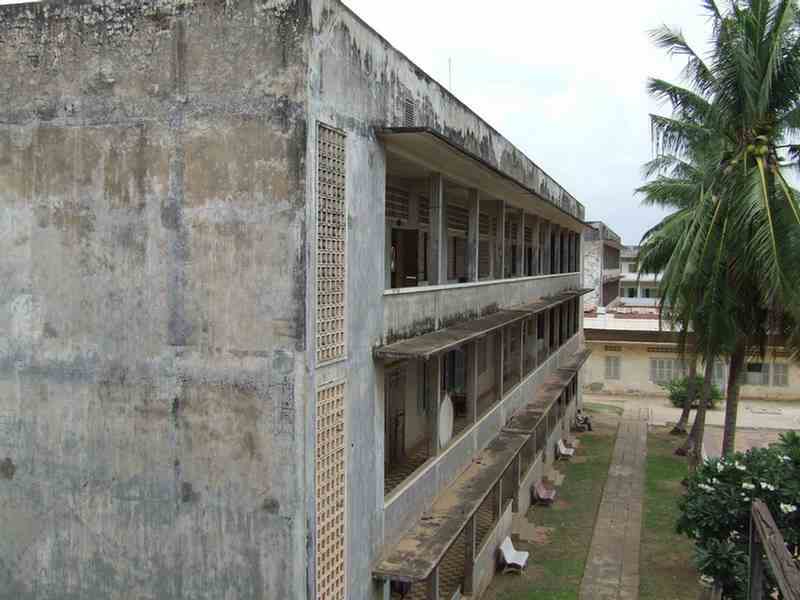
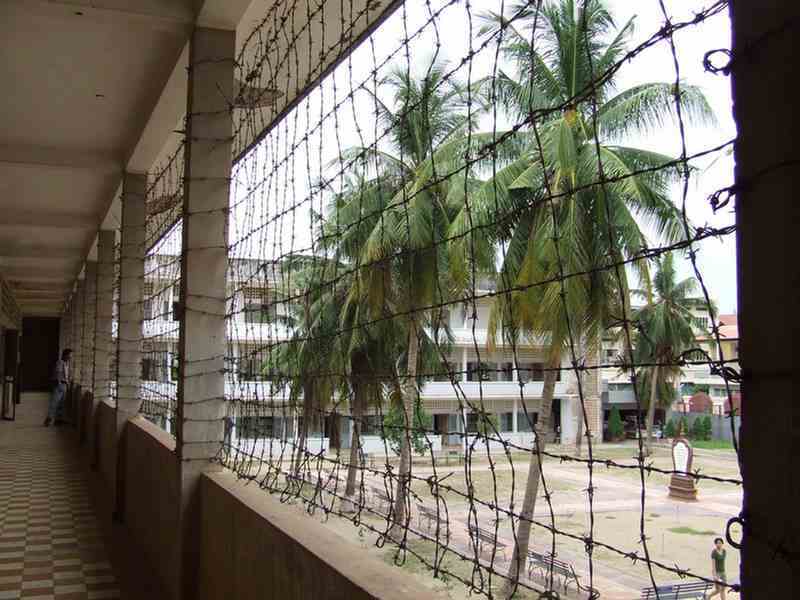
A very depressing place.
All this happened while I was teaching at a school that had a very similar sized 3-story classroom block.
What is also sad is that the chief of the prison was Khang Khek Ieu (also known as Comrade Duch),
a former mathematics teacher who worked closely with Khmer Rouge leader Pol Pot.
Choeung Ek - The Killing Fields
Choeung Ek, the site of a former orchard and Chinese graveyard about 17km south of Phnom Penh, is the best-known
of the sites known as The Killing Fields, where the Khmer Rouge regime executed about 17,000 people
between 1975 and 1979.
Mass graves containing 8,895 bodies were discovered at Choeung Ek after the fall of the Khmer Rouge regime.
Many of the dead were former inmates in the Tuol Sleng prison.
Today, Choeung Ek is a memorial, marked by a Buddhist stupa.
The stupa has acrylic glass sides and is filled with more than 5,000 human skulls.
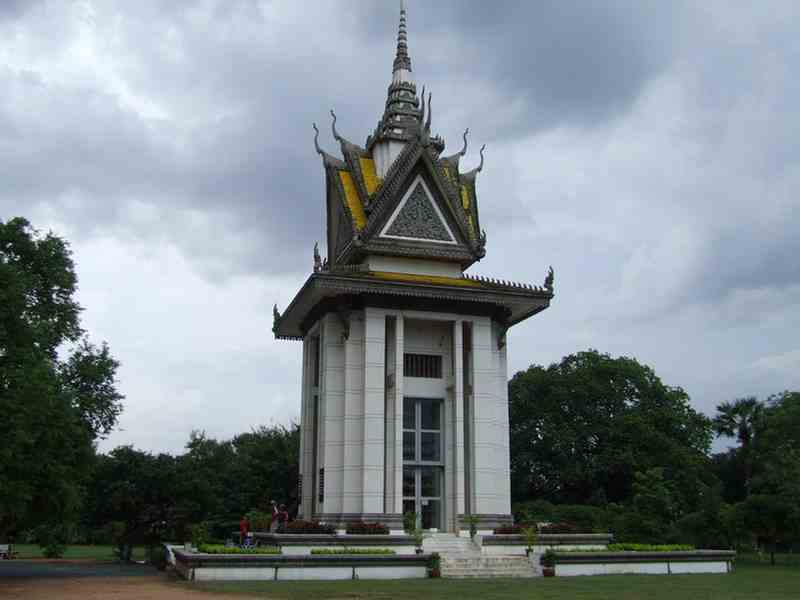
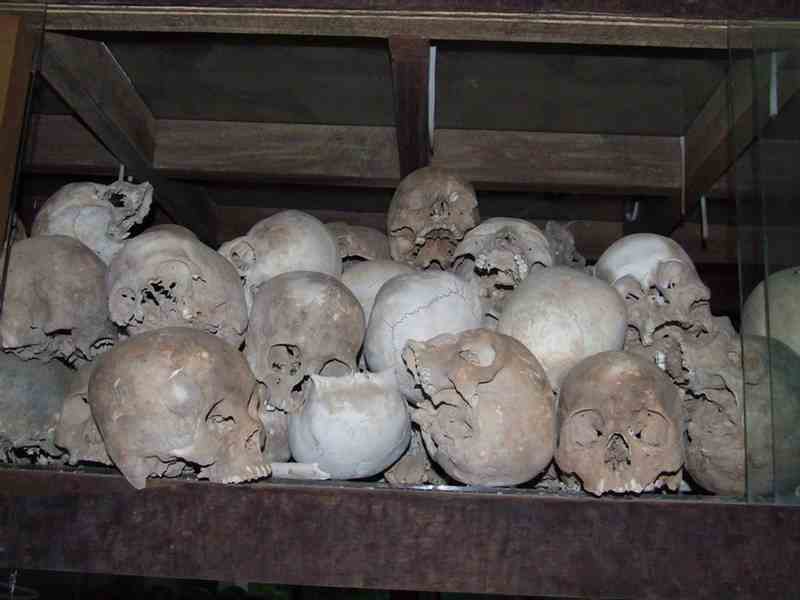
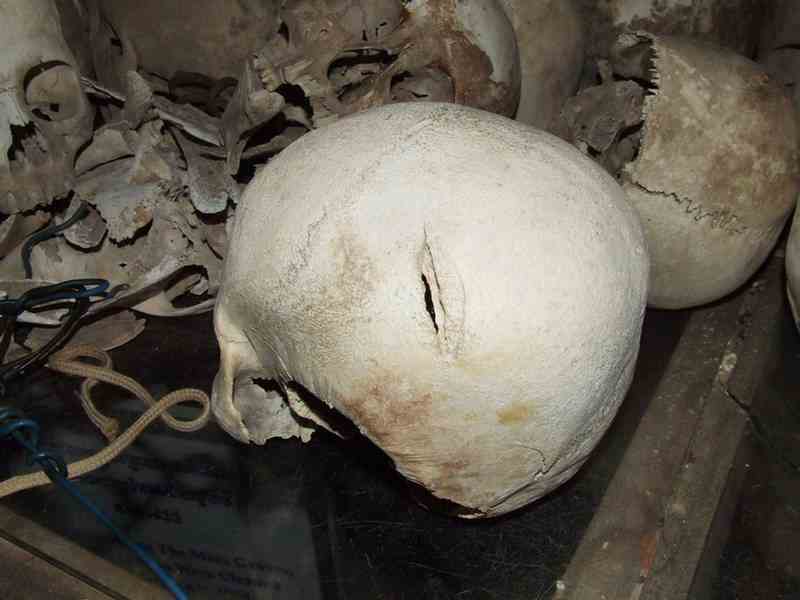
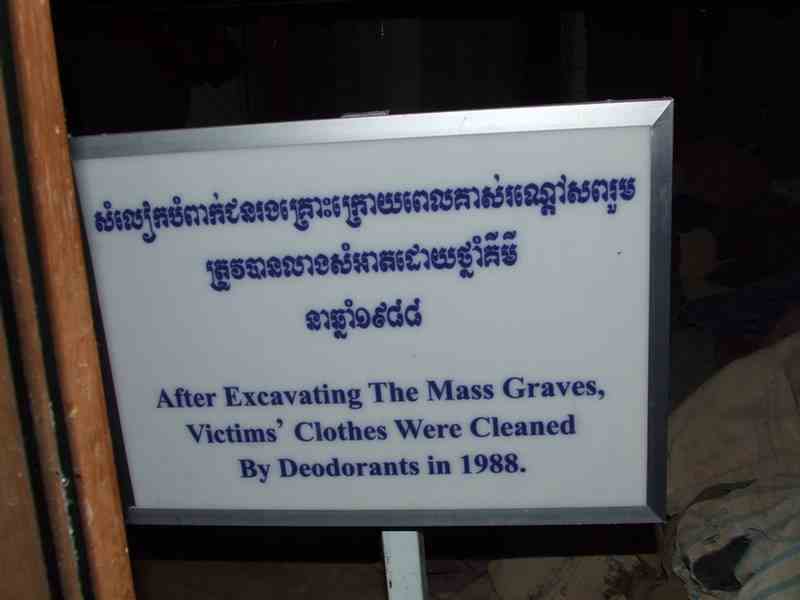
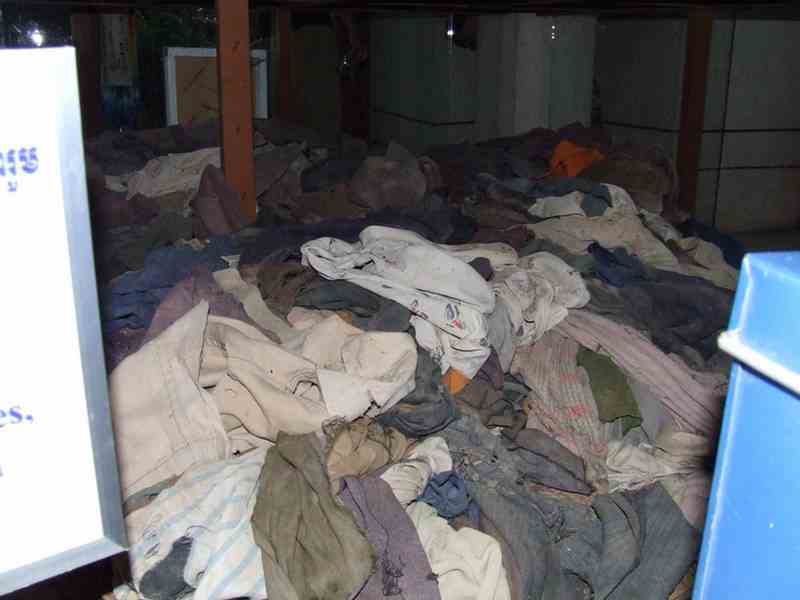
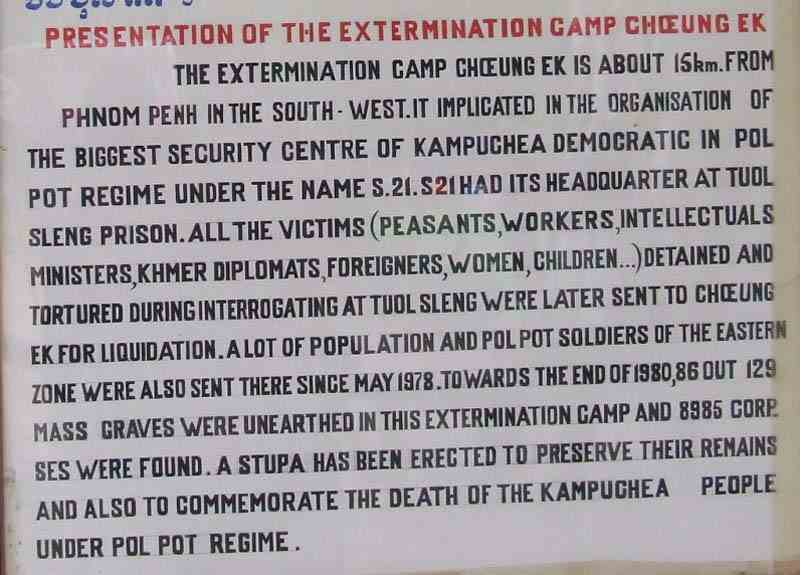
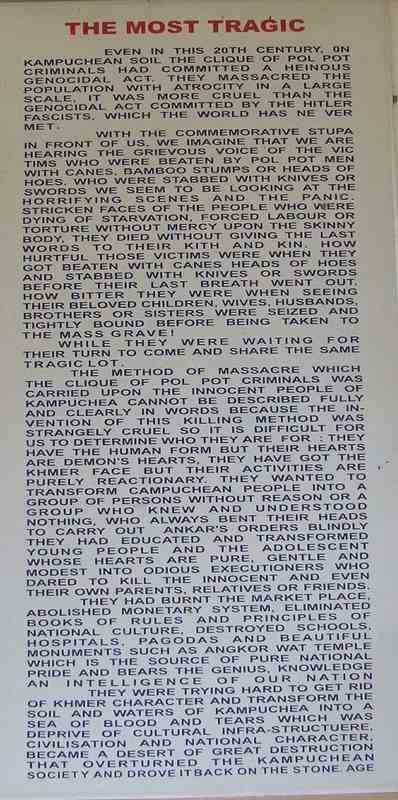
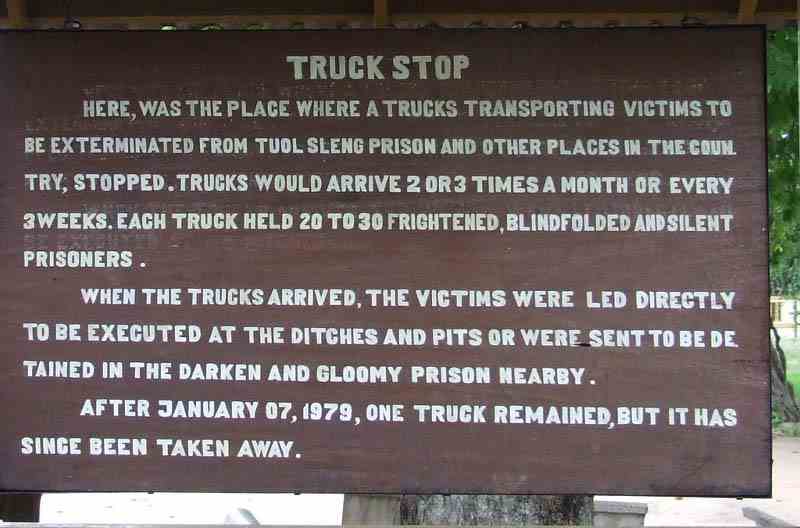

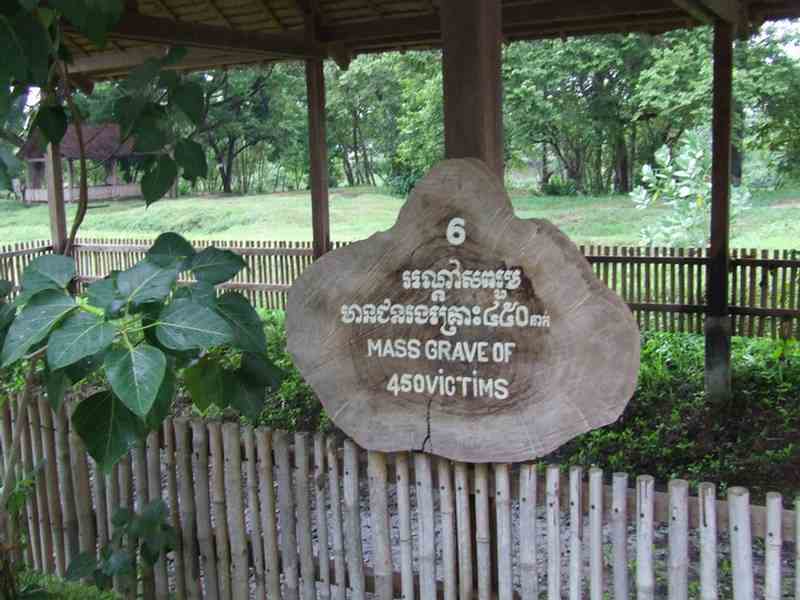
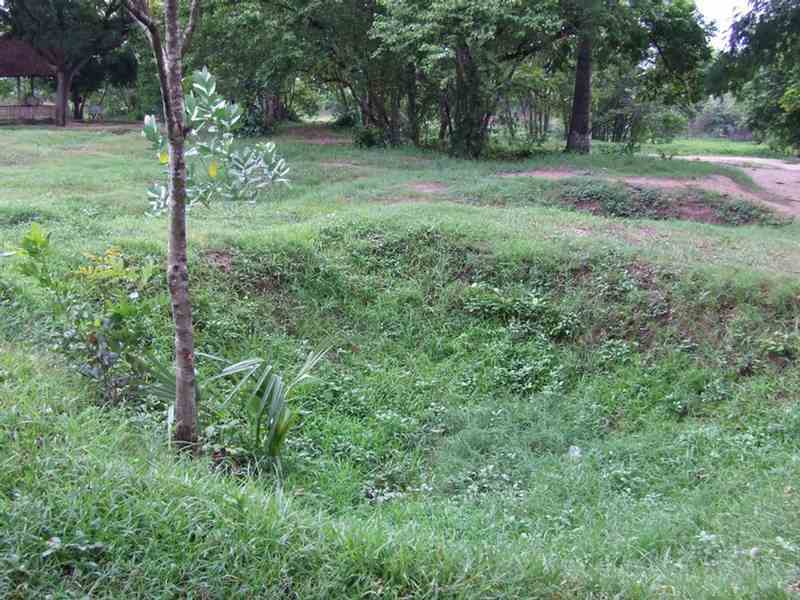

Mass grave of more than 100 victims - children and women - most without heads.
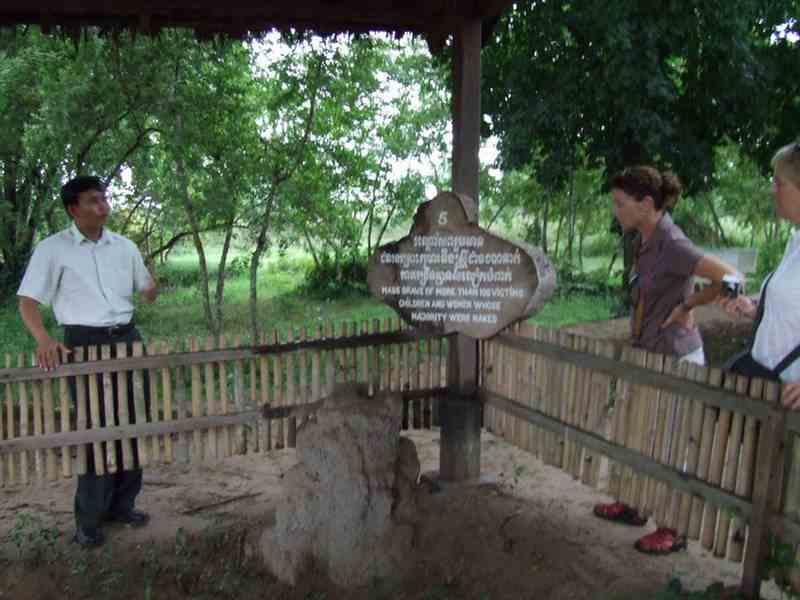
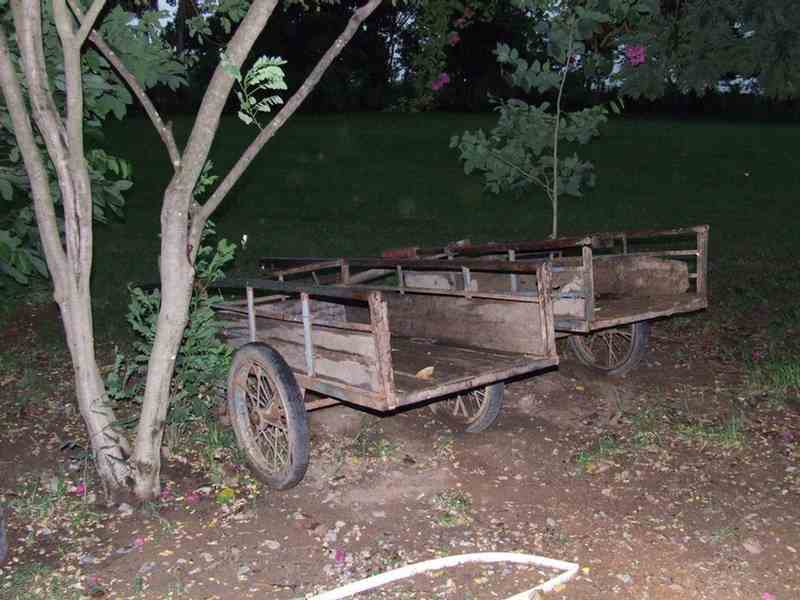
Another very depressing place. As depressing as Auswich.
The photos at the killing fields are dark because a massive thunderstorm was brewing.
It poured down and the roads were under about 60cm of water.
Motor cycle riders were huddled in groups under service station roofs.
The next day we flew to Siem Reap
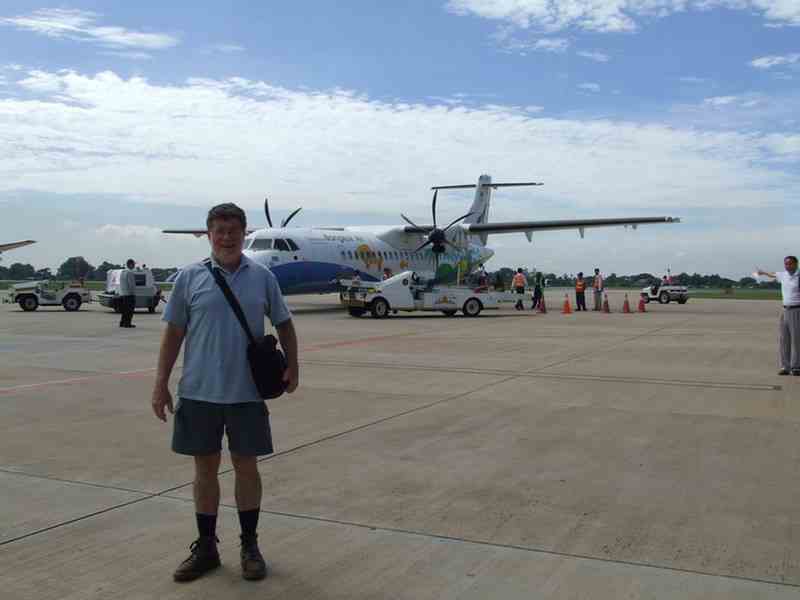
Phnom Penh
I had a 4-week Indochina trip in May-June 2007.
(Melbourne – Bangkok – Thailand – Laos - Vietnam - Cambodia -Thailand – Bangkok - Melbourne)
After 11 days in Vietnam we headed by public bus, (the only one used by IntrepidTravel on this trip), to the Cambodian border.
It simplified the task of getting the Cambodian visa ($30) as the conductor on the bus did all the paperwork.
The Cambodian official handing the bus conductor our passports at the Moc Bai (Vietnam) - Bavet (Cambodia) border.

A basket of fruit of the lotus flower.
In Cambodia, the lotus flower is most often found on the periphery of flooded rice paddies or in stagnant pagoda ponds.
In other Asian countries, the plant’s flowers, leaves, stems, and rootstalks are prepared as garnishes and teas,
or used as vegetables in salads and stir fries.
The plant is also traditionally used for medicinal purposes. It contains the morphine-like alkaloids nuciferine and aporphine.
Throughout the world, the lotus’ dried seed pods are used in floral arrangements, and in Burma,
silk-like robes for monks and Buddha images are painstakingly woven from the fibres found in the lotus’ stalk.
To Cambodians, however, the lotus has one true function, its seeds are a tasty snack.
The lotus’ fruit, or seed pod (which bears an uncanny resemblance to the spout of a common garden watering can),
is commonly sold throughout the Khmer Kingdom.


We crossed the Mekong River on a ferry at Neak Loeung


We drove along the Mekong River into Phnom Penh



















Wat Phnom
Located on a small hill, the Wat marks the legendary founding place of Phnom Penh.
Legend has it that in 1372, Lady Penh (Yea Penh) fished a floating koki tree out of the river.
Inside the tree were four Buddha statues. She built a small hill (phnom means hill)
and a small Temple (Wat) at what is now known as Phnom Penh.
The current temple was built in 1926. The large stupa contains the remains of
King Ponhea Yat (1404-1467) who moved the capital from Angkor to Phnom Penh in 1422.










The Royal Palace
The building of the Royal Palace began in 1866 and opened in 1870 under King Norodom.
The compound houses the Royal Residence, the Throne Hall, the Silver Pagoda along with other buildings.
It is set in pleasant gardens.



The Throne Hall
The Khmer name for the Throne Hall is Preah Thineang Dheva Vinnichay meaning the "Sacred Seat of Judgement."
The Throne Hall is where the king's confidants, generals and royal officials once carried out their duties.
It is still in use today as a place for religious and royal ceremonies (such as coronations and royal weddings)
as well as a meeting place for guests of the King.
The central, 59 meter spire is topped with the white, four-faced head of Brahma.

Chan Chhaya Pavilion
The Preah Thineang Chan Chhaya ("Moonlight Pavilion"), is an open-air pavilion that serves
as stage for Khmer classical dance in the past and present.
It is one of the most notable buildings of the palace as it easily seen from the outside
as it was built along side a section of the palace walls.
The Chan Chhaya Pavilion has a balcony that was used as a platform
for viewing parades marching along Sothearos Boulevard of Phnom Penh.





Some of the garden's shrubs would make a coiffed French poodle green with envy





Out of character is the Napoleon III Pavilion. Constructed in 1876, it was originally built for
French Empress Eugenias, wife of Napoleon III, to use in the inauguration of the Suez Canal.






The Silver Pagoda houses many national treasures such as gold and jeweled Buddha statues.
Most notable is a small 17th century baccarat crystal Buddha (the "Emerald Buddha" of Cambodia)
and a near-life-size, Maitreya Buddha encrusted with 2,086 diamonds dressed in royal regalia
commissioned by King Sisowath.
During King Norodom Sihanouk's pre-Khmer Rouge reign, the Silver Pagoda was inlaid with more
than 5,329 silver tiles and some of its outer facade was remodelled with Italian marble.
Most of the the silver tiles on the floor were covered with carpet.
However there were areas where you could see the beautifully etched tiles.
It is the most notable Wat in the Phnom Penh, and the official temple of the King of Cambodia.










The pavilion from where the royals mounted the royal elephants











The National Museum
The National Museum is near the Royal Palace but was a bit hard to find.
This distinctive rust-coloured building in traditional Khmer style was inaugurated in 1920 by King Sisowat.
The roof space is home to the largest bat colony in the world living in an artificial structure.
Every evening these bats flock out of the roof and swarm around in the sky before searching for food.


I made some new friends here.




Some friendly university students.






The Independence Monument is a single tower of Angkorian style, standing in the heart of the capital.
It was built in 1958 to celebrate Cambodian Independence from France on the 9th November 1953.
Today, it also serves as a monument to Cambodia’s war dead.
Its unique look distinguishes it from all the other structures in the city,

Doing you homework on the way to school - Cambodian style


Toul Sleng Genocide Museum
The site is a former high school which was used as the notorious Security Prison 21 (S-21) by the Khmer Rouge regime
from its rise to power in 1975 to its fall in 1979.
Tuol Sleng in Khmer means "Hill of the Poisonous Trees" or "Strychnine Hill".
From 1975 to 1979, an estimated 17,000 people were imprisoned at Tuol Sleng.
The prisoners were selected from all around the country, and usually were former
Khmer Rouge members and soldiers, accused of betraying the party or revolution.
Those arrested included some of the highest ranking communist politicians.
Although the official reason for their arrest was "espionage," these men may have been viewed by
Khmer Rouge leader Pol Pot as potential leaders of a coup against him.
Even though the vast majority of the victims were Cambodian, foreigners were also imprisoned and executed.
Formerly the Tuol Svay Prey High School, named after a Royal ancestor of King Norodom Sihanouk,
the five buildings of the complex were converted in August 1975, four months after the Khmer Rouge won the civil war,
into a prison and interrogation centre.
The Khmer Rouge renamed the complex "Security Prison 21" (S-21) and construction began to adapt the prison to the inmates.
The buildings were enclosed in electrified barbed wire, the classrooms converted into tiny prison and torture chambers,
and all windows were covered with iron bars and barbed wire to prevent escapes.
Most prisoners at S-21 were held there for two to three months.
However, several high-ranking Khmer Rouge cadres were held longer.
Within two or three days after they were brought to S-21, all prisoners were taken for interrogation.
For the first year of S-21’s existence, corpses were buried near the prison.
However, by the end of 1979, cadres ran out of burial spaces, the prisoner and their family were taken
to the Choeung Ek extermination center (The Killing Fields), fifteen kilometers from Phnom Penh.
In 1979, the prison was uncovered by the invading Vietnamese army. In 1980, the prison was reopened as a historical
museum memorializing the actions of the Khmer Rouge regime.
Out of an estimated 17,000 people imprisoned at Tuol Sleng, there were only twelve known survivors.
One of them,Vann Nath, had trained as an artist and was put to work painting pictures of Pol Pot.
Many of his paintings depicting events he witnessed in Tuol Sleng are on display in the Tuol Sleng Genocide Museum today.



Our local guide, Ran, a 37 yo, was a boy during this time. He was an excellent guide.
His family lived near the Thai border but he lost his father and 3 siblings during the war.
His family set him off alone by himself, so that he appeared to be an orphan.
He worked in the rice fields.








It appears like an electrical engineer was imprisoned in this room


In the early days, detainees who died during torture, were buried here

The blackboard is still in one of the former classrooms



A very depressing place.
All this happened while I was teaching at a school that had a very similar sized 3-story classroom block.
What is also sad is that the chief of the prison was Khang Khek Ieu (also known as Comrade Duch),
a former mathematics teacher who worked closely with Khmer Rouge leader Pol Pot.
Choeung Ek - The Killing Fields
Choeung Ek, the site of a former orchard and Chinese graveyard about 17km south of Phnom Penh, is the best-known
of the sites known as The Killing Fields, where the Khmer Rouge regime executed about 17,000 people
between 1975 and 1979.
Mass graves containing 8,895 bodies were discovered at Choeung Ek after the fall of the Khmer Rouge regime.
Many of the dead were former inmates in the Tuol Sleng prison.
Today, Choeung Ek is a memorial, marked by a Buddhist stupa.
The stupa has acrylic glass sides and is filled with more than 5,000 human skulls.












Mass grave of more than 100 victims - children and women - most without heads.


Another very depressing place. As depressing as Auswich.
The photos at the killing fields are dark because a massive thunderstorm was brewing.
It poured down and the roads were under about 60cm of water.
Motor cycle riders were huddled in groups under service station roofs.
The next day we flew to Siem Reap
